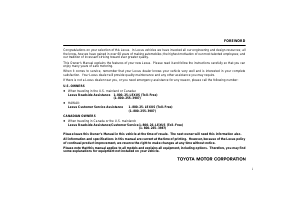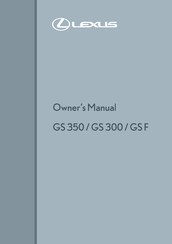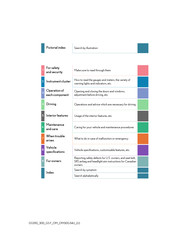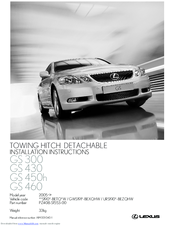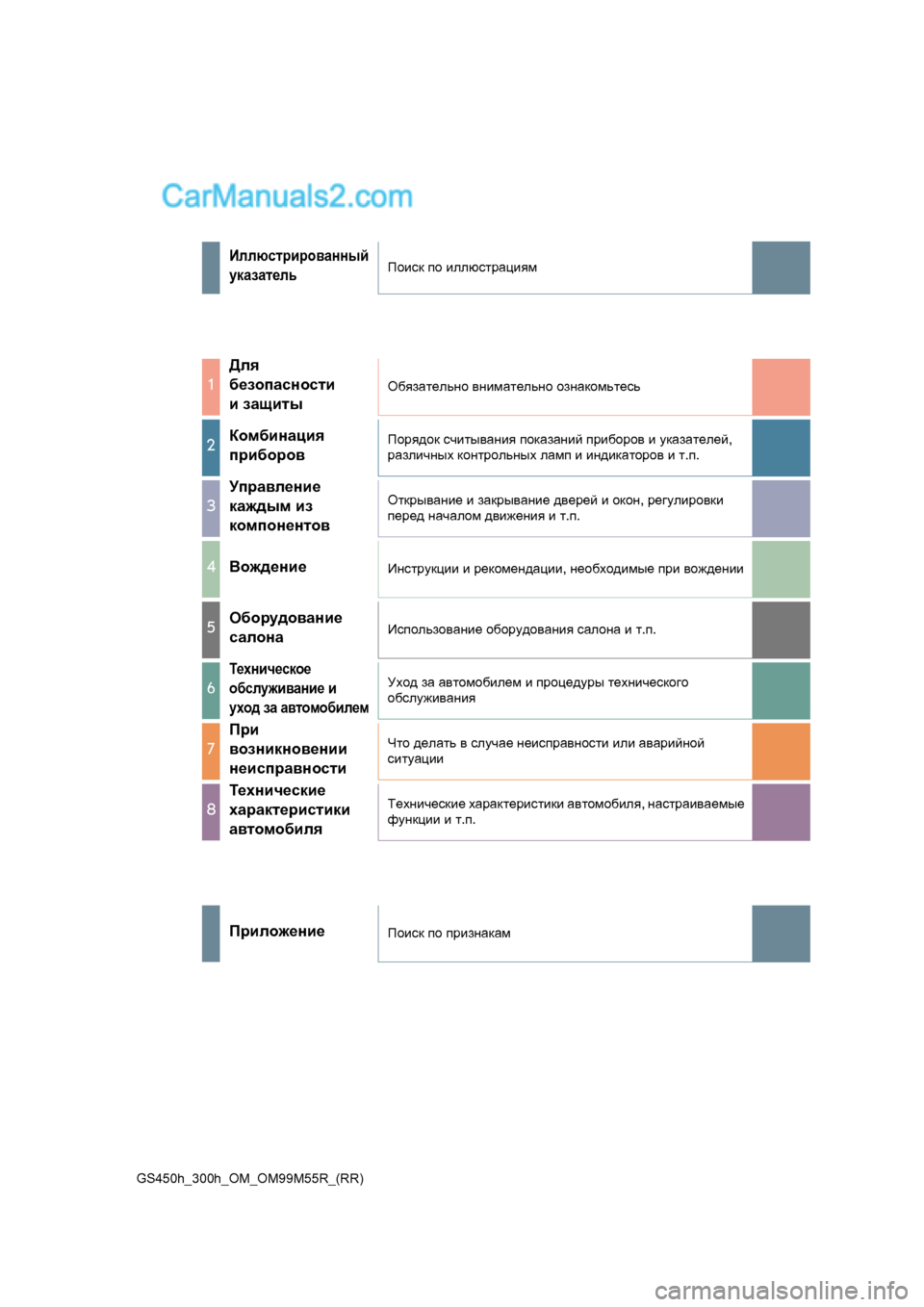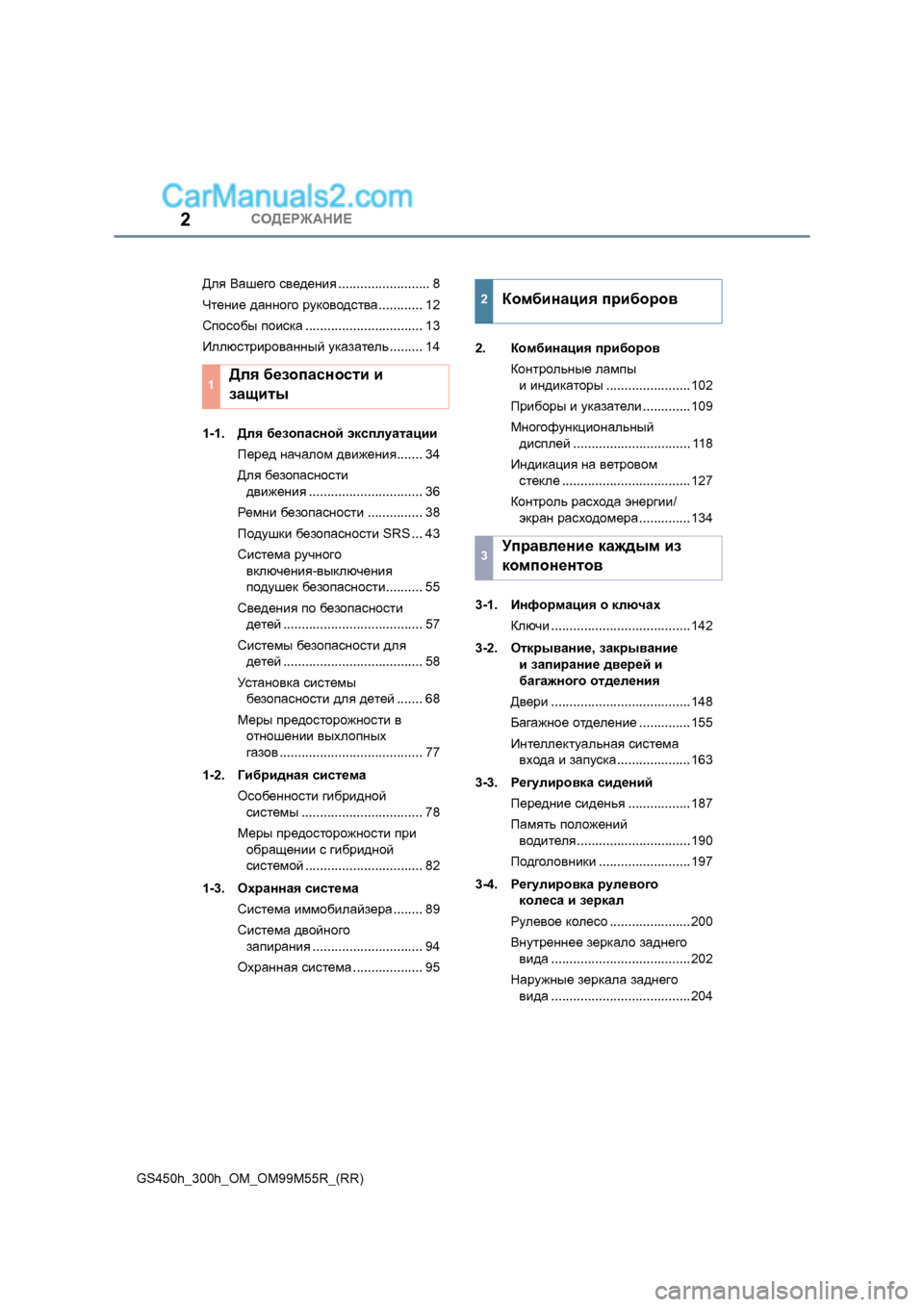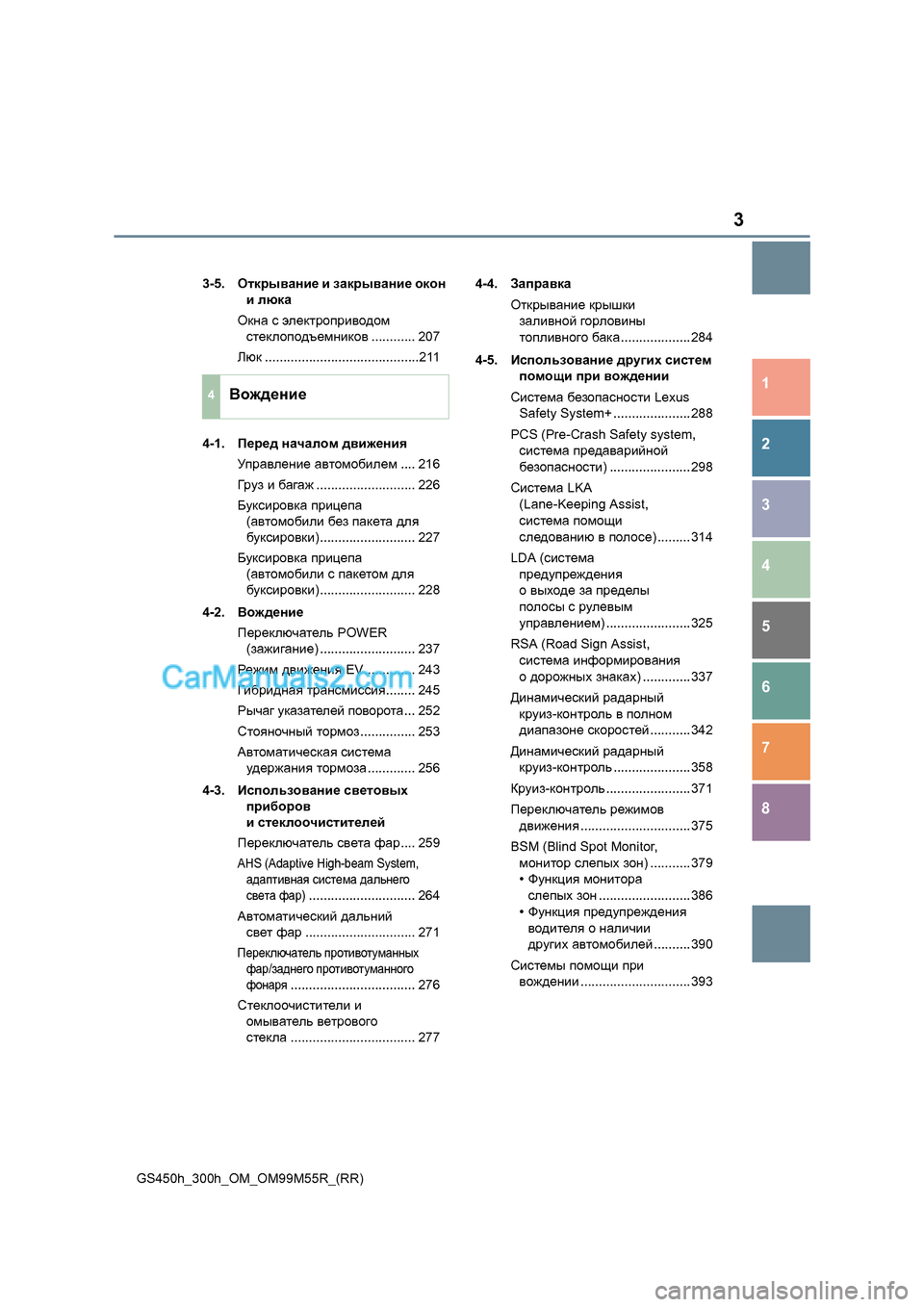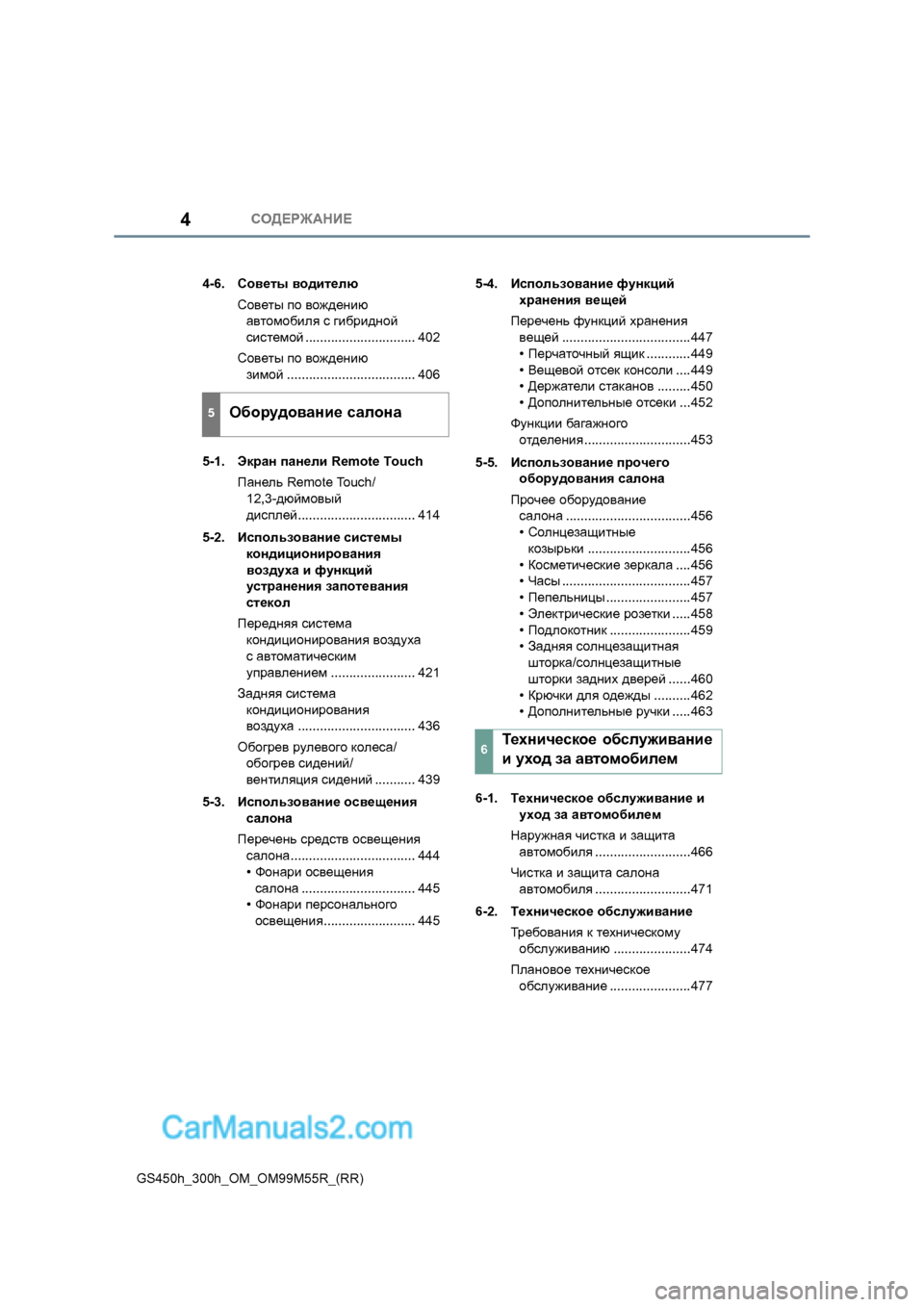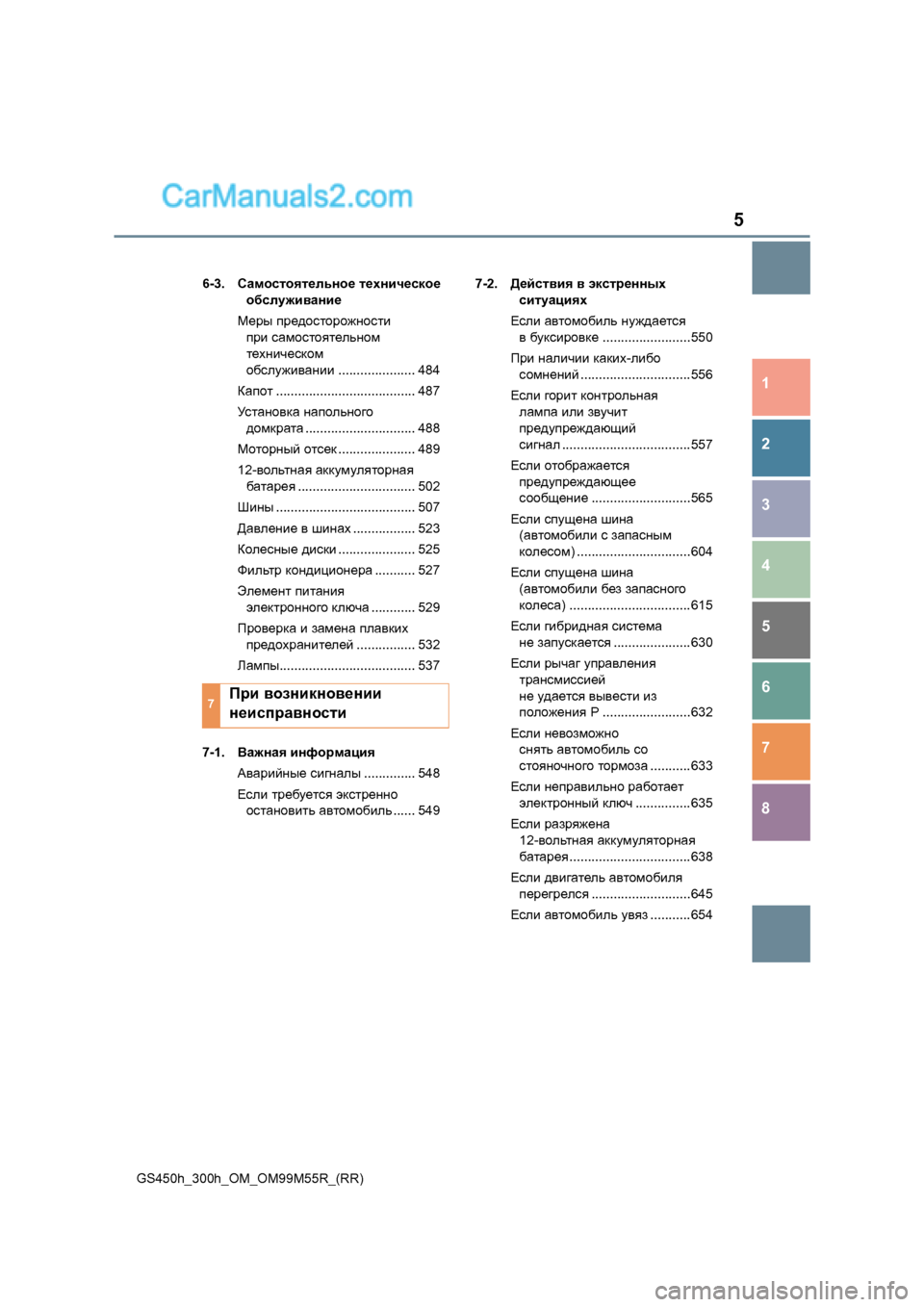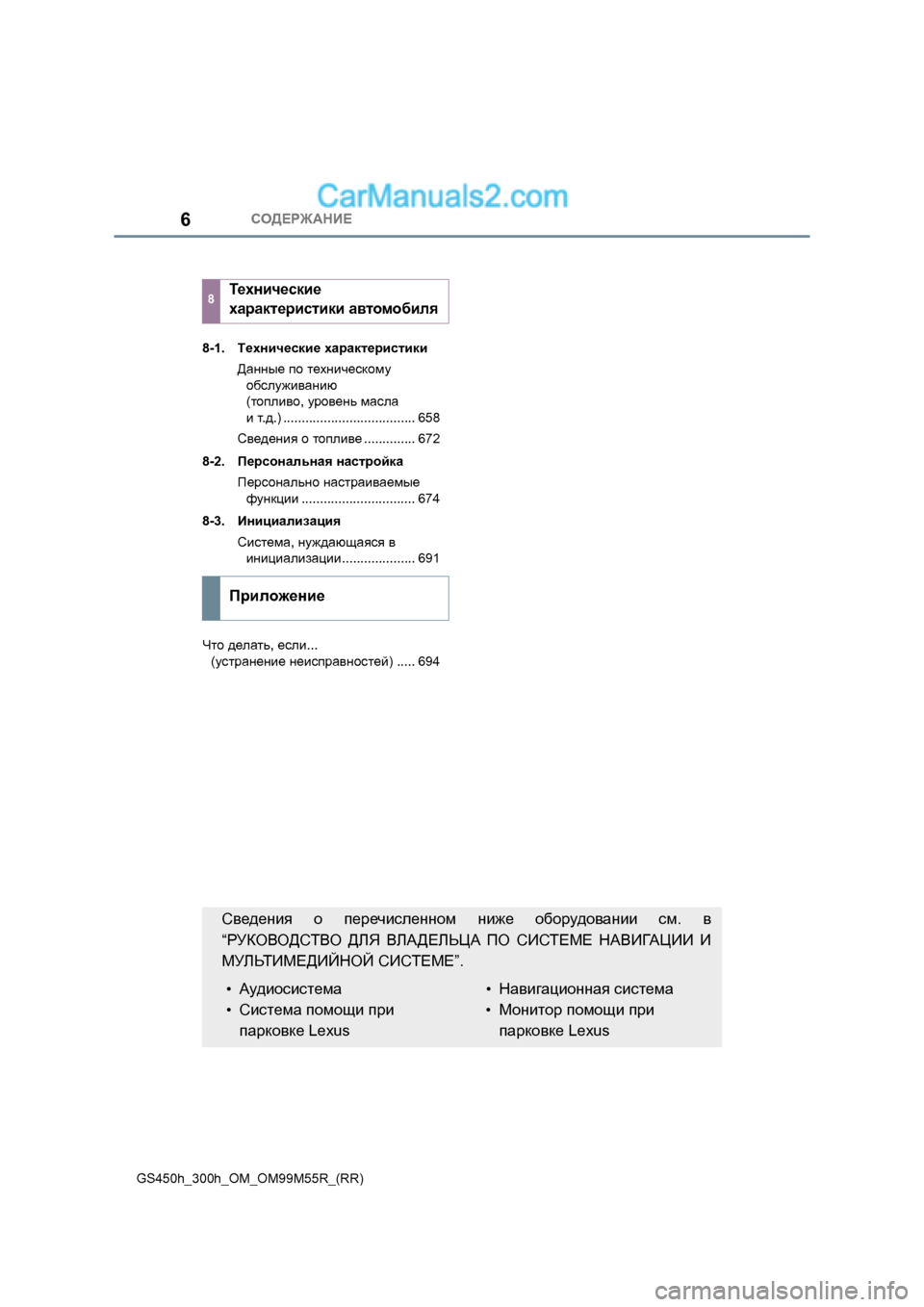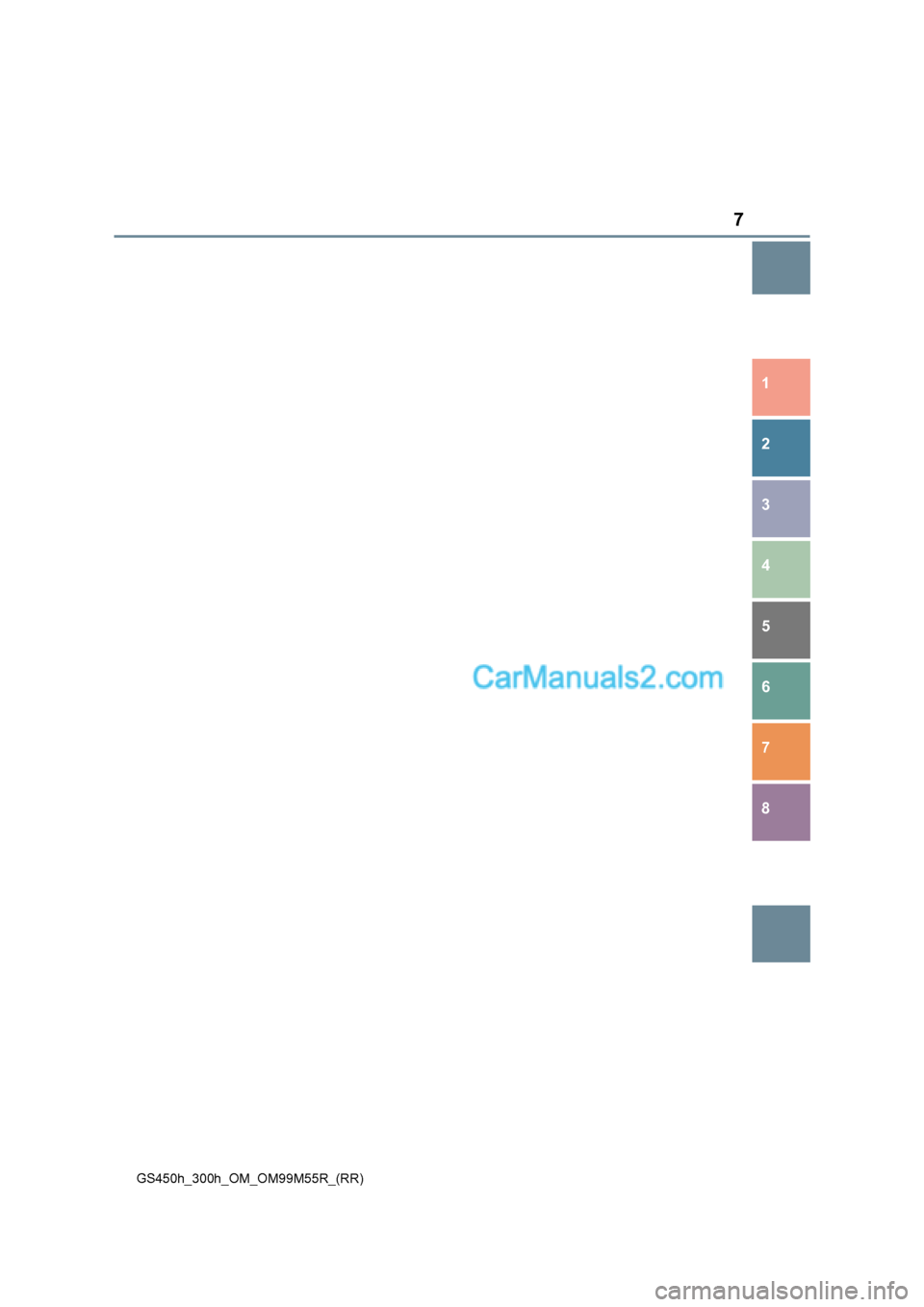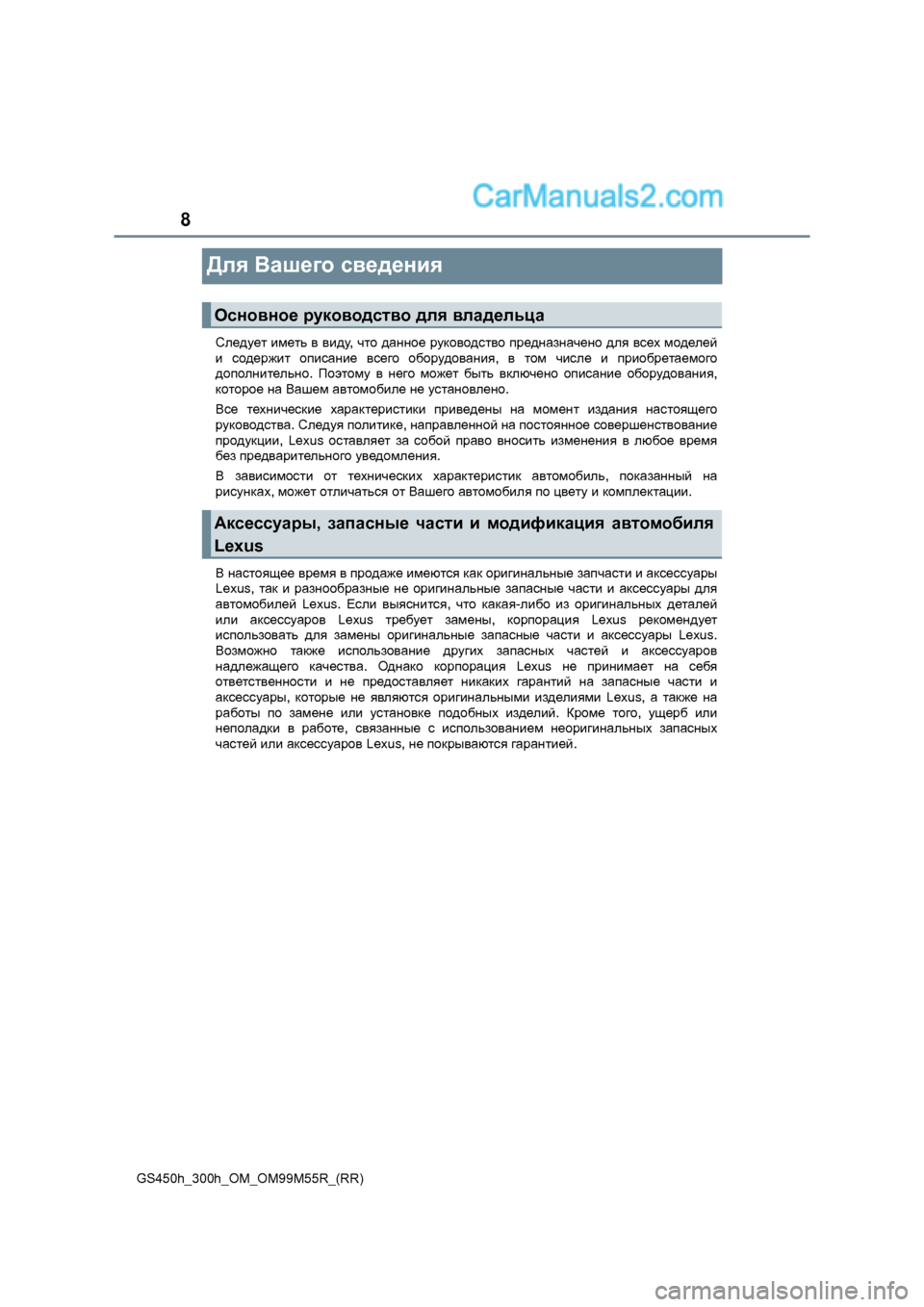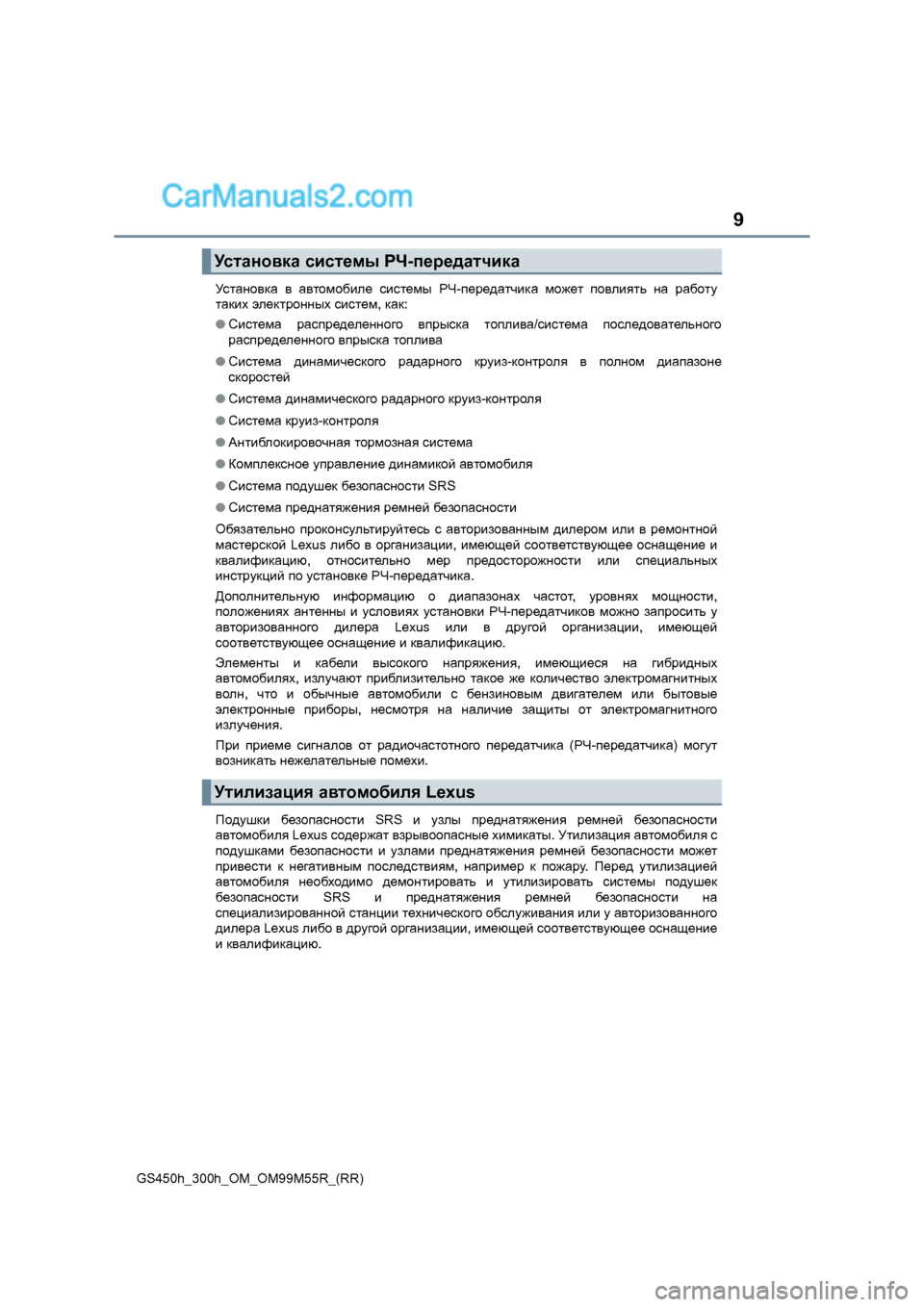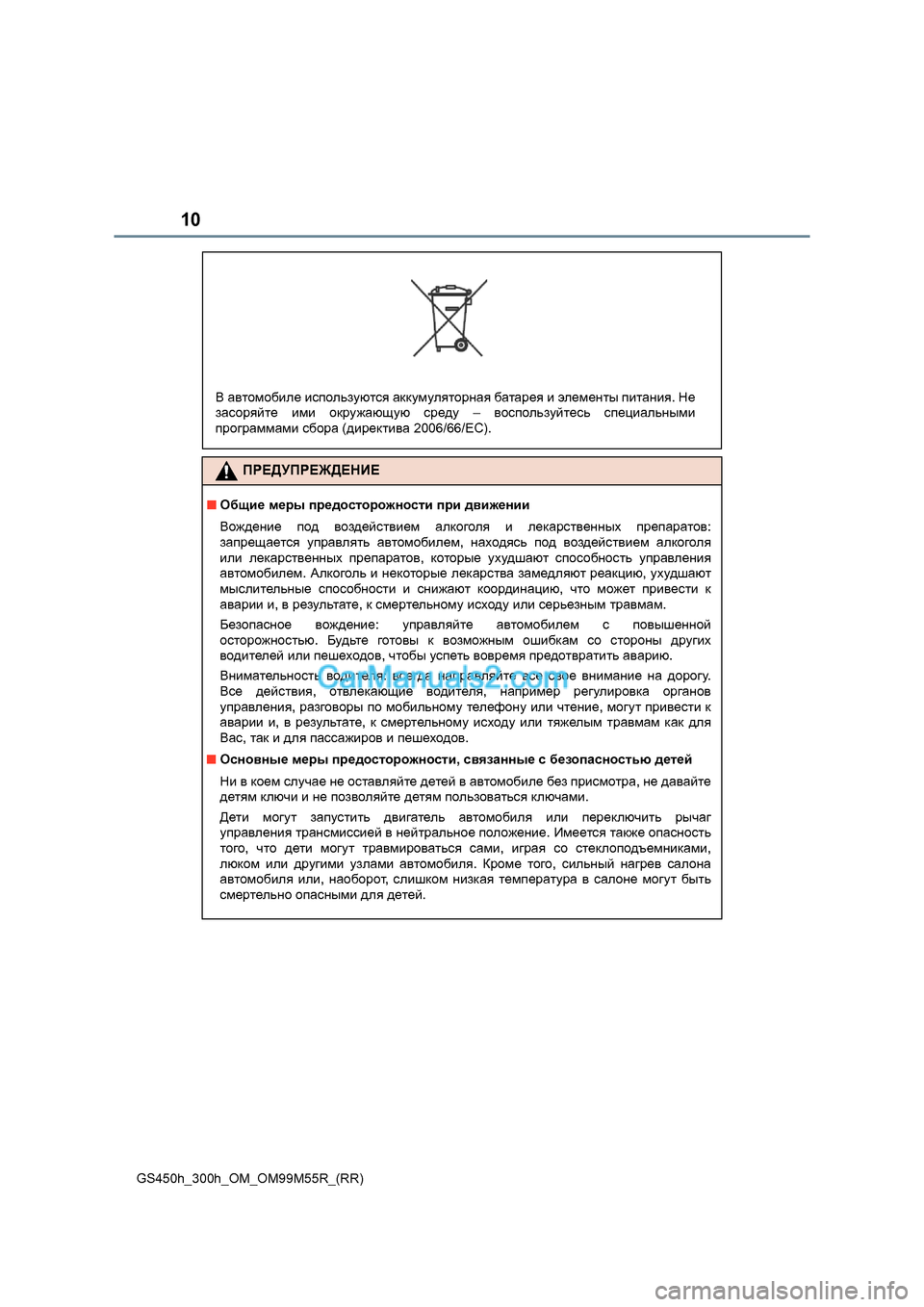- Manuals
- Brands
- Lexus Manuals
- Automobile Accessories
- GS300
Manuals and User Guides for Lexus GS300. We have 4 Lexus GS300 manuals available for free PDF download: Owner’s Manual, User Manual, Installation Instructions Manual
Lexus GS300 User Manual (623 pages)
Brand: Lexus
|
Category: Automobile
|
Size: 10.63 MB
Table of Contents
-
Important Information about Occupant Restraint Systems
2
-
Event Data Recorder
3
-
Table of Contents
6
-
How to Use this Manual
6
-
Instrument Panel (Vehicles with Navigation System)
9
-
Pictorial Index
10
-
Instrument Panel (Vehicles Without Navigation System)
11
-
Audio System
12
-
Instrument Cluster
13
-
Front Seat
17
-
Steering Wheel and Column
18
-
Switch Box
19
-
Exterior View
20
-
Basic Operation
22
-
Quick Reference
22
-
Driver’s Seat
23
-
Quick Reference
23
-
Steering Wheel
23
-
Automatic Transmission Overview
24
-
Headlight and Turn Signal Switches
26
-
Headlight Dimmer Switch
26
-
Windshield Wiper Switch
27
-
-
Instruments and Controls
28
-
Keys and Doors
29
-
Using a Mechanical Key
29
-
Smart Access System with Push−Button Start
31
-
Engine Immobilizer
32
-
Entry Functions
34
-
Alarms and Warning Messages
36
-
Locking the Doors with Entry Function
40
-
Unlocking the Doors with Entry Function
43
-
Changing the Doors to be Unlocked
44
-
Unlocking the Trunk Lid with Entry Function
45
-
Battery Power Saving
47
-
Starting the Engine When the Electronic Key Battery Is Discharged
48
-
Wireless Remote Control
49
-
Locking/Unlocking the Doors
51
-
Sounding an Alarm
52
-
Unlocking the Trunk Lid
52
-
Operating the Windows and Moon Roof
53
-
Replacing the Battery
54
-
Doors — Locking with a Mechanical Key
56
-
Locking Doors with Inside Lock Button
57
-
Locking Doors with Power Door Lock Switch
58
-
Automatic Door Locking and Unlocking Functions
59
-
Locking with Rear Door Child−Protector
61
-
-
Theft Deterrent System
61
-
Testing the Theft-Deterrent System
63
-
Instruments and Controls
64
-
-
Mirror Defogger Switch
64
-
Headlight Switch
65
-
Switches
65
-
Daytime Running Light System
66
-
Adaptive Front Lighting System (AFS)
67
-
Automatic Headlight Leveling System
67
-
-
Headlight Dimmer and Turn Signal Switches
68
-
Fog Light Switch
69
-
Windshield Wiper and Washer Switches
70
-
Rain−Sensing Windshield Wipers
71
-
Shifting the Windshield Wiper Position
74
-
-
Headlight Cleaner Switch
76
-
Rear Window and Outside Rear View Mirror Defogger Switch
77
-
Power Window Switches
78
-
Operating the Window Lock Switch
79
-
Operating the Windows from Outside the Vehicle
79
-
If the Battery Is Disconnected or Run down
80
-
Jam Protection Function
80
-
-
Emergency Flasher Switch
81
-
Seat Heater Switches
82
-
Seat Ventilator/Heater Switches
84
-
Seat Ventilator
85
-
Seat Heater
86
-
-
Engine Coolant Temperature Gauge
89
-
Fuel Gauge
89
-
-
Gauges, Meters and Service Reminder Indicators
89
-
Tachometer
90
-
Odometer and Trip Meter
91
-
Light Sensitive Optitron Meter
92
-
Service Reminder Indicators and Warning Buzzers
93
-
Brake System Warning Light (Red) and Buzzer
95
-
Brake System Warning Light (Yellow)
96
-
Driver’s Seat Belt Reminder Light and Buzzer
96
-
-
Front Passenger’s Seat Belt Reminder Light
97
-
SRS Warning Light
97
-
Discharge Warning Light
98
-
Malfunction Indicator Lamp
98
-
Master Warning Light
99
-
”ABS” Warning Light
99
-
Adaptive Front Lighting System off Indicator Light
100
-
Low Tire Pressure Warning Light
100
-
Open Door Warning Light
100
-
Electric Power Steering System Warning Light
101
-
Key Reminder Buzzer
101
-
Low Fuel Level Warning Light
101
-
Pre−Collision System Warning Light
101
-
How to Check All the Service Reminder Indicators
102
-
Cruise Information
103
-
-
Multi−Information Display
103
-
Graphic Information
105
-
Warning Messages
105
-
Headlight Leveling System Failure Warning
106
-
Moon Roof Warning
106
-
Parking Brake Release Warning
106
-
Trunk Open Warning
106
-
Low Engine Oil Pressure Warning
107
-
Low Washer Fluid Warning
107
-
Rear Lights System Failure Warning
107
-
Engine Oil Maintenance Reset Warning
108
-
Low Engine Oil Level Warning
108
-
Engine Oil Replacement Reminder
109
-
Electronic Brake System Failure Warning
110
-
Four−Wheel Drive System Warning
110
-
Variable Gear Ratio Steering System Warning
110
-
Tire Pressure Warning
111
-
Electronic Key System Warning
112
-
Lexus Park Assist System Warning
113
-
Radar Cruise Control Warning
114
-
Pre−Collision System Warning
116
-
-
Instrument Panel Light Control
117
-
-
Interior Equipment
119
-
Interior Lights
119
-
Sun Visors
119
-
Personal Lights
120
-
Illuminated Entry System
121
-
Outer Scuff Lights and Courtesy Lights
122
-
Selector Lever Spot Light
122
-
Lighting Table
123
-
-
Clock
124
-
Luggage Compartment Light
124
-
To Adjust a Clock
126
-
To Set the Daylight Saving Time
126
-
-
Outside Temperature Display
127
-
Cigarette Lighter and Ashtray
128
-
Power Outlet
129
-
Rear Ashtray
129
-
Rear Console Box
130
-
Glove Box
131
-
Garage Door Opener
132
-
Programming the Homelink
132
-
Programming a Rolling Code System
134
-
Programming an Entrance Gate
134
-
Erasing the Entire Homelink Memory
135
-
Operating the Homelink
135
-
Reprogramming a Button
135
-
-
Cupholders
136
-
Coin Boxes
137
-
Overhead Console Box
138
-
Door Pockets
139
-
Floor Mat
140
-
Trunk Storage Extension
140
-
Rear Electric Sunshade
141
-
First−Aid Kit Holder
143
-
Tie−Down Hooks
143
-
Exterior Equipment
144
-
Hood
145
-
-
Exterior Equipment
145
-
Trunk Lid
146
-
Trunk Lid Opener Main Switch
147
-
Trunk Lid Closer
148
-
Using a Mechanical Key (Trunk Lid)
148
-
-
Fuel Tank Cap
149
-
Internal Trunk Release Handle
149
-
In Case the Opener Is Not Actuated
152
-
-
Moon Roof
153
-
Operating the Moon Roof from Outside the Vehicle
154
-
Occupant Restraint Systems
158
-
Front Seats Precautions
159
-
-
Occupant Restraint Systems
159
-
Adjusting Front Seats
161
-
Seat Adjustment Precautions
161
-
Adjusting Seat Position
162
-
Adjusting Seat Cushion Angle and Height
163
-
Adjusting Seatback Angle
163
-
Adjusting Lumbar Support
164
-
Rear Seats Precautions
164
-
Armrest
165
-
Head Restraints
165
-
Seat Belts
168
-
Fastening Front and Rear Seat Belts
170
-
Seat Belt Comfort Guides
172
-
Seat Belt Extender
173
-
Seat Belt Pretensioners
176
-
-
SRS Driver Airbag and Front Passenger Airbag
179
-
SRS Side Airbags and Curtain Shield Airbags
189
-
Cupholders
195
-
Child Restraint
199
-
Types of Child Restraint System
201
-
Child Seats Installation with 3-Point Type Seat Belt
202
-
Infant Seat Installation
202
-
Convertible Seat Installation
206
-
Booster Seat Installation
211
-
Using a Top Strap
214
-
To Use the Anchor Bracket
215
-
Child Seat Installation with Child Restraint Lower Anchorages
216
-
-
Driving Position Memory System
219
-
Recalling the Memorized Position
219
-
Setting the Driving Position
219
-
Conditions for Memorized Position Activation
220
-
Memory Recall Function
220
-
Resetting the Driving Position on the Electronic Key
220
-
Setting the Driving Position Onto the Electronic Key
220
-
-
Front Passenger Seat Position Memory System
221
-
Steering Wheel and Mirrors
224
-
Tilt and Telescopic Steering Column
225
-
-
Steering Wheel and Mirrors
225
-
Automatic Tilt Away
226
-
Outside Rear View Mirrors
226
-
Power Rear View Mirror Control
227
-
Folding Rear View Mirrors
228
-
Outer Foot Lights
229
-
-
Inside Rear View Mirror
230
-
Compass
231
-
Calibrating the Compass (Deviation Calibration)
232
-
Calibrating the Compass (Circling Calibration)
233
-
-
Vanity Mirrors
235
-
-
Touch Screen
237
-
Initial Screen
238
-
Touch Switch Operation
238
-
Information Menu
239
-
Trip Information
239
-
Hands−Free System
241
-
Bluetooth
245
-
Entering the Bluetooth Phone
246
-
Selecting the Bluetooth Phone
248
-
To Confirm the Bluetooth Information
250
-
To Reconnect the Bluetooth Phone
250
-
To Change the Device Name
251
-
To Change the Passkey
252
-
Deleting the Bluetooth Phone
253
-
Calling on the Bluetooth Phone
254
-
Receiving on the Bluetooth Phone
260
-
Talking on the Bluetooth Phone
260
-
Changing the Settings of the Bluetooth Phone
262
-
To Change the Phone Book
263
-
To Transfer the Telephone Number
263
-
To Register the One Touch Dial
265
-
To Delete the Memory
266
-
To Delete the Dialed Number
267
-
To Delete the Received Calls
268
-
To Delete the One Touch Dial
269
-
Language
270
-
Setting Screen
271
-
Screen Adjustment
272
-
Color and Tone Adjustment
273
-
Automatic Air Conditioning Controls
275
-
Air Flow Selection
278
-
Climate Control
279
-
“DUAL” Switch
280
-
Air Conditioning Manual Control
281
-
Windshield Defogging and Defrosting
284
-
Micro Dust and Pollen Filter
285
-
Heating
286
-
Operating Tips (Air Conditioning)
286
-
Air Conditioning
287
-
Ventilation
287
-
Defogging and Defrosting
288
-
Center Vents, Side Vents and Rear Vents
289
-
Replacing the Air Conditioning Filter
290
-
The Air Conditioning Filter
291
-
Audio System
295
-
Using Your Audio System: some Basics
299
-
Turning the Audio System On, Volume Control and Mode Selection
300
-
Tone and Balance
302
-
Automatic Sound Levelizer (ASL)
303
-
DSP Control
303
-
Positioning Selector
303
-
Your Cassette Player
304
-
Your Radio Antenna
304
-
Radio Operation
305
-
Your Automatic Changer
305
-
Presetting a Station
306
-
Selecting a Station
307
-
RDS (Radio Data System)
308
-
Displaying the Radio ID
310
-
How to Subscribe to an XM Satellite Radio
310
-
Radio Operation (XM Satellite Radio Broadcast)
310
-
Listening to the Satellite Radio
311
-
Presetting a Channel
312
-
Selecting a Channel
312
-
Channel Category
313
-
Displaying the Title and Name
314
-
If the Satellite Radio Tuner Malfunctions
315
-
Cassette Tape Player Operation
317
-
CD Player Operation
321
-
Inserting or Ejecting Cds
321
-
Playing a CD
323
-
Searching for a Desired Disc
324
-
Selecting a Desired Disc
324
-
Searching for a Desired Track
325
-
Selecting a Desired Track
325
-
Other CD Player Functions
326
-
If the CD Player Malfunctions
327
-
DVD Player Operation (for a Mark Levinson Brand Audio System)
328
-
Operating a DVD Video Disc
335
-
Precautions on DVD Video Disc
335
-
Playing a DVD Video Disc
336
-
Displaying Operation Switches
337
-
Description of each Switch
338
-
Angle Mark
342
-
DVD Language
342
-
Parental
342
-
Subtitle Language
342
-
Entry of Language Code
343
-
Operating a Video CD
347
-
DVD Player and DVD Video Disc Information
350
-
If the DVD Player Malfunctions
350
-
DVD Video Disc Glossary
351
-
Audio Remote Control (Steering Switches)
352
-
Audio System Operating Hints
354
-
Caring for Your Cassette Player and Tapes
354
-
Radio Reception
354
-
Caring for Your CD Player or DVD Player, and Discs
355
-
Starting and Driving
360
-
Three−Way Catalytic Converters
361
-
Engine Exhaust Caution
362
-
Operating the Engine Switch
363
-
To Select “ACC”, “IG−ON” or “OFF” Mode
365
-
“ACC” Mode
366
-
“IG−ON” Mode
366
-
“OFF” Mode
367
-
Steering Lock
368
-
Before Cranking
370
-
How to Start the Engine
370
-
Normal Starting Procedure
371
-
Stopping the Engine
372
-
-
Parking Brake
373
-
Automatic Transmission
374
-
Normal Driving
375
-
Driving Pattern Selector Switch
376
-
AI (Artificial Intelligence) Shifting Control
377
-
Driving in “S” Mode
378
-
Shift Range Positions
378
-
Maximum Allowable Speeds
379
-
Using Engine Braking
380
-
“S” Mode Indicator Light
380
-
Backing up
383
-
Good Driving Practice
384
-
Parking
384
-
-
Automatic Transmission Selector Lever
385
-
Electronic Throttle Control System
385
-
If You Cannot Shift the Selector Lever
385
-
Intuitive Parking Assist
386
-
Where to Display (Parking Assist)
388
-
Indicators and Steering Guide Symbol
389
-
Dual Sensors
390
-
Collision will be Unavoidable
391
-
Collision will be Avoided by Changing the Steering
392
-
Collision will be Avoided with the Present Steering Angle
393
-
Rear Corner Sensors
394
-
Back Sensors
395
-
Numerous Obstacles Are Detected on the Front and Rear Simultaneously
396
-
Detection Range of Sensors
397
-
Intuitive Parking Assist Failure Warning
399
-
When Snowflakes or Mud Gets on the Sensors
400
-
When the Sensor Is Malfunctioning
400
-
When the Neutral Point of the Steering Sensor Is Unknown
401
-
When the Steering Sensor Is Malfunctioning
401
-
When the Detection Range of the Sensors Is Shorter
402
-
Rear View Monitor Display
403
-
Setting the Intuitive Parking Assist
406
-
Changing the Volume of the Beeps
407
-
Display Setting (Parking Assist)
408
-
Explanations of Parking Sonar Symbols
408
-
-
Rear View Monitor System
409
-
Area Displayed on Screen
411
-
Rear View Monitor System Camera
412
-
-
Cruise Control
413
-
Cancelling the Preset Speed
414
-
Cruise Control Setting Operation
414
-
Resetting to a Faster Speed
414
-
Setting at a Desired Speed
414
-
Cruise Control Failure Warning
415
-
Resetting to a Slower Speed
415
-
Resuming the Preset Speed
415
-
-
Dynamic Radar Cruise Control
416
-
Changing the Dynamic Radar Cruise Control Mode
417
-
Vehicle−To−Vehicle Distance Control Mode
417
-
Dynamic Radar Cruise Control Operations
418
-
Turning the Dynamic Radar Cruise Control System on
422
-
Setting Operation (Dynamic Radar Cruise Control)
423
-
Braking Control
428
-
Approach Warning
429
-
Millimeter Wave Radar Sensor
430
-
Vehicle−To−Vehicle Distance Control Mode Failure Warning
431
-
Conventional (Fixed Speed) Cruise Control Mode
433
-
-
Adaptive Variable Suspension System
438
-
Conventional Cruise Control Mode Failure Warning
438
-
Slip Indicator Light
439
-
-
Traction Control System
439
-
Traction Control off Mode
440
-
Traction Control System Failure Warning
441
-
-
Vehicle Stability Control System
441
-
Hill−Start Assist Control System
443
-
Vehicle Stability Control Failure Warning
443
-
Hill−Start Assist Control System Failure Warning
445
-
-
Variable Gear Ratio Steering System
445
-
Variable Gear Ratio Steering System Failure Warning
446
-
Vehicle Dynamics Integrated Management
447
-
Brake Booster
448
-
Brake System
448
-
Anti−Lock Brake System
449
-
“ABS” Warning Light
451
-
Brake Assist System
452
-
-
Brake Pad Wear Limit Indicators
452
-
Drum−In−Disc Type Parking Brake System
452
-
Electric Power Steering System
453
-
Tire Pressure Warning System
454
-
Tire Pressure Warning System Malfunction
458
-
Replacing Tires and Wheels
460
-
-
Tire Pressure Warning System Reset Switch
461
-
Selector Switch
463
-
Pre−Collision System
464
-
Pre−Collision Sensor
465
-
Pre−Collision Brake Assist System
466
-
Pre−Collision Seat Belts
466
-
Adaptive Variable Suspension Control
467
-
Pre−Collision System Failure Warning
467
-
Precaution for Pre−Collision System
468
-
Driving Tips
470
-
Starting and Driving
470
-
-
Break−In Period
471
-
Operation in Foreign Countries
471
-
Tips for Driving in Various Conditions
471
-
Winter Driving Tips
473
-
Dinghy Towing
474
-
How to Save Fuel and Make Your Vehicle Last Longer
475
-
Trailer Towing
475
-
Vehicle Load Limits
477
-
Cargo and Luggage
478
-
Stowage Precautions
478
-
Capacity and Distribution
479
-
Steps for Determining Correct Load Limit
479
-
In Case of an Emergency
482
-
-
If Your Engine Stalls While Driving
483
-
If Your Vehicle will Not Start
483
-
Jump Starting
484
-
Starting a Flooded Engine
484
-
-
If You Cannot Increase Engine Speed
487
-
If Your Vehicle Overheats
488
-
If You Have a Flat Tire (Vehicles with Run−Flat Tires)
489
-
If You Have a Flat Tire (Vehicles with Standard Tires)
490
-
Compact Spare Tire
492
-
Access to Spare Tire
494
-
To Remove the Spare Tire
496
-
-
If Your Vehicle Becomes Stuck
502
-
If Your Vehicle Needs to be Towed
503
-
Towing with a Wheel Lift Type Truck
503
-
Using a Flat Bed Truck
505
-
Towing with a Sling Type Truck
506
-
Emergency Towing
507
-
Emergency Towing Eyelet Precautions
508
-
Installing Towing Eyelet
509
-
Tips for Towing a Stuck Vehicle
509
-
If You Cannot Shift Automatic Transmission Selector Lever
510
-
-
If You Lose Your Keys or Lock Yourself out
511
-
Maintenance
512
-
Maintenance Requirements
513
-
Scheduled Maintenance
513
-
General Maintenance
514
-
Vehicle Interior Maintenance
515
-
Vehicle Exterior Maintenance
516
-
Does Your Vehicle Need Repairing?
517
-
Emission Inspection and Maintenance (I/M) Programs
518
-
Service Procedures and Specifications
520
-
-
Introduction
521
-
Vehicle Identification
521
-
Theft Prevention Labels
522
-
Engine Compartment Overview
523
-
Engine Compartment Overview (GS300)
524
-
Removing the Engine Compartment Cover
525
-
Do−It−Yourself Service Precautions
526
-
Positioning the Jack
528
-
Parts and Tools
529
-
Engine Specifications
533
-
Specifications (GS430)
533
-
Lubrication System Data
534
-
Cooling System Data
535
-
Electrical System Data
535
-
Ignition System Data
535
-
-
Specifications (GS300)
536
-
Fuel Type
539
-
Gasoline Containing Detergent Additives
539
-
Octane Rating
539
-
Quality Gasoline
539
-
Cleaner Burning Gasoline
540
-
Gasoline Containing MMT
540
-
Gasoline Quality
540
-
Oxygenates in Gasoline
540
-
-
Facts about Engine Oil Consumption
541
-
Fuel Pump Shut off System
541
-
Importance of Engine Oil Level Check
542
-
Checking the Engine Oil Level
543
-
Used Engine Oil
543
-
Engine Oil Selection
546
-
Oil Identification Marks
547
-
-
Checking the Engine Coolant Level
548
-
Coolant Type Selection
549
-
Checking the Radiator and Condenser
550
-
Spark Plugs
550
-
Chassis Specifications
553
-
Specifications (GS430)
553
-
Tires and Wheels Data
555
-
Specifications (GS300)
556
-
Checking Brake Fluid
559
-
Checking Tire Inflation Pressure
560
-
Inspection and Adjustment Procedure
561
-
Tire Information
563
-
Tire Symbols (Standard and Run−Flat Tire)
563
-
Tire Symbols (Compact Spare Tire)
565
-
DOT and Tire Identification Number (TIN)
567
-
Tire Size
567
-
Name of each Section of Tire
568
-
Temperature A, B, C
569
-
Traction AA, A, B, C
569
-
Treadwear
569
-
Uniform Tire Quality Grading
569
-
Glossary of Tire Terminology
570
-
-
Run−Flat Tires
573
-
All Season Tires
574
-
Summer Tires
574
-
-
Types of Tires
574
-
Checking and Replacing Tires
575
-
Rotating Tires
575
-
Tire Selection
578
-
Installing Snow Tires and Chains
579
-
Replacing Wheels
581
-
When to Replace Your Wheels
581
-
Aluminum Wheel Precautions
582
-
Wheel Selection
582
-
Suspension and Chassis
583
-
Electrical Components Specifications
585
-
Fuses
585
-
-
Checking Battery Condition
592
-
Checking Battery Exterior
593
-
Battery Recharging Precautions
595
-
Checking and Replacing the Blade Type Fuses
595
-
Checking the Cartridge Type Fuses
598
-
Adding Washer Fluid
600
-
Checking the Headlight Aim
600
-
Adjusting the Headlight Aiming (Low Beam)
601
-
Adjusting the Headlight Aiming (High Beam)
603
-
-
Replacing Light Bulbs
605
-
Body Specifications
611
-
Dimensions and Weight
611
-
-
Protecting Your Vehicle from Corrosion
612
-
Washing and Waxing
613
-
Cleaning the Interior
615
-
Advertisement
Lexus GS300 Owner’s Manual (670 pages)
Brand: Lexus
|
Category: Automobile
|
Size: 6.89 MB
Table of Contents
-
Table of Contents
3
-
For Your Information
9
-
Reading this Manual
13
-
How to Search
14
-
Pictorial Index
15
-
1-1. for Safe Use
47
-
Before Driving
47
-
For Safe Driving
49
-
Seat Belts
51
-
SRS Airbags
55
-
Safety Information for Children
64
-
Child Restraint Systems (Except for Taiwan)
65
-
Child Restraint Systems (for Taiwan)
71
-
Installing Child Restraints
76
-
Exhaust Gas Precautions
86
-
-
1-2. Theft Deterrent System
87
-
Engine Immobilizer System
87
-
Alarm
90
-
-
2 Instrument Cluster
96
-
Warning Lights and Indicators
97
-
Indicators
100
-
Gauges and Meters (GS350/GS300)
105
-
Gauges and Meters (GS F)
110
-
Multi-Information Display (GS350/GS300)
118
-
Multi-Information Display (GS F)
126
-
Head-Up Display
137
-
Fuel Consumption Information
144
-
Fuel Consumption
144
-
Information
144
-
-
3 Operation of each Component
148
-
3-1. Key Information
149
-
Keys
149
-
-
Opening, Closing and Locking the Doors and Trunk
154
-
Doors
154
-
Trunk
161
-
Smart Entry & Start System
168
-
-
Adjusting the Seats
178
-
Front Seats
178
-
Driving Position Memory
181
-
Head Restraints
186
-
-
3-4. Adjusting the Steering Wheel and Mirrors
189
-
Steering Wheel
189
-
Inside Rear View Mirror
191
-
Outside Rear View Mirrors
193
-
-
Opening, Closing the Windows and Moon Roof
196
-
Power Windows
196
-
Moon Roof
199
-
-
-
4 Driving
204
-
4-1. before Driving
205
-
Driving the Vehicle
205
-
Cargo and Luggage
213
-
Trailer Towing (Vehicles Without Towing Package)
214
-
Trailer Towing (Vehicles with Towing Package)
215
-
-
Driving Procedures
222
-
Engine (Ignition) Switch
222
-
Automatic Transmission
227
-
Turn Signal Lever
235
-
Parking Brake
236
-
Brake Hold
239
-
ASC (Active Sound Control) (GS F)
241
-
-
Operating the Lights and Wipers
242
-
Headlight Switch
242
-
AHS (Adaptive High-Beam System)
246
-
Automatic High Beam
251
-
Fog Light Switch
254
-
Windshield Wipers and Washer
256
-
-
Refueling
262
-
Opening the Fuel Tank Cap
262
-
-
Using the Driving Support Systems
266
-
Lexus Safety System
266
-
PCS (Pre-Crash Safety System)
273
-
(Lane-Keeping Assist)
286
-
-
LDA (Lane Departure Alert with Steering Control)
296
-
Dynamic Radar Cruise Control with Full-Speed Range
306
-
Dynamic Radar Cruise Control
319
-
Cruise Control
331
-
Driving Mode Select Switch
334
-
BSM (Blind Spot Monitor)
338
-
The Blind Spot Monitor Function
343
-
The Rear Cross Traffic Alert Function
345
-
-
TVD (Torque Vectoring Differential) (GS F)
348
-
Driving Assist Systems
350
-
-
Driving Tips
358
-
Winter Driving Tips
358
-
Eco-Friendly Driving Tips
363
-
-
-
5 Interior Features
366
-
5-1. Remote Touch Screen
367
-
Display
367
-
Remote Touch Screen
368
-
Display
371
-
-
Using the Air Conditioning System and Defogger
374
-
Front Automatic Air Conditioning System
374
-
Rear Air Conditioning System
387
-
Heated Steering Wheel/Seat Heaters/Seat Ventilators
390
-
-
5-3. Using the Interior Lights
395
-
Interior Lights List
395
-
Interior Lights
396
-
Personal Lights
396
-
-
-
Using the Storage Features
398
-
List of Storage Features
398
-
Glove Box
399
-
Console Box
400
-
Cup Holders
401
-
Auxiliary Boxes
403
-
-
Trunk Features
404
-
-
Using the Other Interior Features
408
-
Other Interior Features
408
-
Sun Visors
408
-
Vanity Mirrors
408
-
Ashtrays
409
-
Clock
409
-
Power Outlets
410
-
Armrest
411
-
Rear Door Sunshades
412
-
Rear Sunshade
412
-
Trunk Storage Extension
414
-
Assist Grips
415
-
Coat Hooks
415
-
-
Garage Door Opener
416
-
-
-
6 Maintenance and Care
422
-
Cleaning and Protecting the Vehicle Exterior
423
-
Maintenance and Care Cleaning and Protecting the Vehicle Exterior
423
-
Cleaning and Protecting the Vehicle Interior
428
-
6-2. Maintenance
431
-
Requirements
431
-
Scheduled Maintenance
433
-
-
6-3. Do-It-Yourself Maintenance
449
-
Do-It-Yourself Service Precautions
449
-
Hood
451
-
Positioning a Floor Jack
452
-
Engine Compartment
454
-
Tires
474
-
Tire Inflation Pressure
485
-
Wheels
487
-
Air Conditioning Filter
489
-
Electronic Key Battery
491
-
Checking and Replacing Fuses
494
-
Light Bulbs
499
-
-
-
7 When Trouble Arises
508
-
7-1. Essential Information
508
-
Emergency Flashers
509
-
If Your Vehicle Has to be Stopped in an Emergency
510
-
If the Vehicle Is Trapped in Rising Water
511
-
-
Steps to Take in an Emergency
512
-
If Your Vehicle Needs to be Towed
512
-
If You Think Something Is Wrong
517
-
Fuel Pump Shut off System
518
-
If a Warning Light Turns on or a Warning Buzzer Sounds
519
-
If a Warning Message Is Displayed
525
-
If You Have a Flat Tire (Vehicles with Spare Tire)
556
-
If You Have a Flat Tire
556
-
With Spare Tire)
556
-
If You Have a Flat Tire (Vehicles Without Spare Tire)
572
-
If You Have a Flat Tire
572
-
Without Spare Tire)
572
-
If the Engine will Not Start
588
-
If the Parking Brake Cannot be Released
590
-
If the Electronic Key Does Not Operate Properly
592
-
If the Vehicle Battery Is Discharged
595
-
If Your Vehicle Overheats
600
-
If the Vehicle Becomes Stuck
606
-
-
Specifications Maintenance Data
608
-
Maintenance Data (Fuel, Oil Level, Etc.)
609
-
Fuel Information
626
-
-
Customization
628
-
Customizable Features
628
-
-
8-3. Initialization
645
-
Item to Initialize
645
-
Index
646
-
-
What to Do if
646
-
(Troubleshooting)
646
-
Alphabetical Index
651
-
Lexus GS300 Owner’s Manual (602 pages)
Brand: Lexus
|
Category: Automobile
|
Size: 12.6 MB
Table of Contents
-
Table of Contents
2
-
Event Data Recorder
10
-
For Your Information
10
-
Reading this Manual
12
-
How to Search
13
-
Pictorial Index
16
-
Instrument Panel
18
-
For Safe Use before Driving
31
-
-
1-1. for Safe Use
32
-
Before Driving
32
-
For Safe Driving
36
-
Seat Belts
36
-
SRS Airbags
43
-
Front Passenger Occupant Classification System
54
-
Safety Information for Children
58
-
Child Restraint Systems
61
-
Installing Child Restraints
65
-
Exhaust Gas Precautions
71
-
-
1-2. Theft Deterrent System
72
-
Alarm
74
-
Engine Immobilizer System
74
-
-
2 Instrument Cluster
77
-
Instrument Cluster Warning Lights
77
-
Warning Lights and Indicators
80
-
Gauges and Meters (GS350/GS300)
86
-
Gauges and Meters (GS F)
92
-
Multi-Information Display (GS350/GS300)
100
-
Multi-Information Display (GS F)
108
-
Multi-Information Display (GS F)
111
-
Head-Up Display
122
-
Fuel Consumption
128
-
Fuel Consumption Information
129
-
-
-
3 Operation of each Component
133
-
3-1. Key Information
134
-
Keys
134
-
-
Opening, Closing and Locking the Doors and Trunk
139
-
Doors
139
-
Trunk
145
-
Smart Access System with Push-Button Start
152
-
-
3-3. Adjusting the Seats
160
-
Front Seats
160
-
Driving Position Memory
162
-
Head Restraints
167
-
-
3-4. Adjusting the Steering Wheel and Mirrors
170
-
Steering Wheel
170
-
Inside Rear View Mirror
171
-
Outside Rear View Mirrors
173
-
-
Opening, Closing the Windows and Moon Roof
177
-
Power Windows
177
-
Moon Roof
180
-
-
-
4 Driving
183
-
4-1. before Driving
184
-
Driving the Vehicle
184
-
Cargo and Luggage
193
-
Vehicle Load Limits
196
-
Trailer Towing
197
-
Dinghy Towing
198
-
-
Driving Procedures
199
-
Engine (Ignition) Switch
199
-
Automatic Transmission
204
-
Turn Signal Lever
212
-
Operating Instructions
212
-
Parking Brake
213
-
Brake Hold
215
-
ASC (Active Sound Control) (GS F)
217
-
-
4-3. Operating the Lights and Wipers
218
-
Headlight Switch
218
-
Automatic High Beam
221
-
Windshield Wipers and Washer
225
-
-
4-4. Refueling
230
-
Opening the Fuel Tank Cap
230
-
-
4-5. Using the Driving Support Systems
234
-
Lexus Safety System
234
-
PCS (Pre-Collision System)
240
-
LKA (Lane-Keeping Assist)
251
-
Dynamic Radar Cruise Control with Full-Speed Range
260
-
Cruise Control
272
-
Driving Mode Select Switch
275
-
(Blind Spot Monitor)
280
-
The Blind Spot Monitor Function
283
-
The Rear Cross Traffic Alert Function
285
-
-
TVD (Torque Vectoring Differential) (GS F)
288
-
Driving Assist Systems
290
-
-
4-6. Driving Tips
298
-
Winter Driving Tips
298
-
-
-
5 Interior Features
303
-
Remote Touch/12.3-Inch Display
304
-
Display
304
-
5-2. Using the Air Conditioning System and Defogger
310
-
Front Automatic Air Conditioning System
310
-
Rear Air Conditioning
311
-
Rear Air Conditioning
312
-
Rear Air Conditioning
314
-
Other Functions
316
-
-
Rear Air Conditioning System
321
-
Air Outlets
322
-
Heated Steering Wheel/ Seat Heaters/Seat Ventilators
324
-
-
Using the Interior Lights
329
-
Interior Lights List
329
-
Interior Lights
330
-
Personal Lights
330
-
-
-
5-4. Using the Storage Features
332
-
List of Storage Features
332
-
Console Box
333
-
Glove Box
333
-
Cup Holders
334
-
Auxiliary Boxes
335
-
-
Trunk Features
336
-
-
5-5. Using the Other Interior Features
340
-
Other Interior Features
340
-
Sun Visors
340
-
Vanity Mirrors
340
-
Ashtrays
341
-
Clock
341
-
Armrest
342
-
Power Outlets
342
-
Rear Door Sunshades
343
-
Rear Sunshade
343
-
Trunk Storage Extension
345
-
Assist Grips
346
-
Coat Hooks
346
-
Garage Door Opener
347
-
LEXUS Enform Safety Connect
354
-
-
-
6 Maintenance and Care
359
-
Cleaning and Protecting the Vehicle Exterior
360
-
Maintenance and Care Cleaning and Protecting the Vehicle Exterior
360
-
Cleaning and Protecting the Vehicle Interior
364
-
Maintenance
367
-
Maintenance Requirements
367
-
Scheduled Maintenance
367
-
General Maintenance
369
-
Vehicle Interior
370
-
Vehicle Exterior
371
-
Emission Inspection and Maintenance (I/M) Programs
372
-
-
Do-It-Yourself Maintenance
373
-
Do-It-Yourself Service Precautions
373
-
Hood
375
-
Positioning a Floor Jack
376
-
Engine Compartment
378
-
Checking Tires
395
-
Tires
395
-
Tire Inflation Pressure
405
-
Wheels
408
-
Air Conditioning Filter
410
-
Electronic Key Battery
412
-
Checking and Replacing Fuses
414
-
Headlight Aim (Vehicles with Single-Beam Headlights)
418
-
Light Bulbs
420
-
-
7-1. Essential Information
425
-
Emergency Flashers
426
-
If Your Vehicle Has to be Stopped in an Emergency
427
-
-
-
-
7 When Trouble Arises
425
-
7-2. Steps to Take in an Emergency
428
-
If Your Vehicle Needs to be Towed
428
-
If You Think Something Is Wrong
434
-
Fuel Pump Shut off System
435
-
If a Warning Light Turns on or a Warning Buzzer Sounds
436
-
If a Warning Message Is Displayed
443
-
If You Have a Flat Tire (Vehicles with Spare Tire)
474
-
If You Have a Flat Tire (Vehicles Without Spare Tire)
485
-
If the Engine will Not Start
499
-
If the Parking Brake Cannot be Released
501
-
If the Electronic Key Does Not Operate Properly
503
-
If the Vehicle Battery Is Discharged
506
-
If Your Vehicle Overheats
511
-
If the Vehicle Becomes Stuck
517
-
-
Specifications Maintenance Data
519
-
(Fuel, Oil Level, Etc.)
520
-
Lubrication System
524
-
Electrical System
528
-
-
Fuel Information
534
-
Tire Information
537
-
Uniform Tire Quality Grading
541
-
-
Customization
547
-
Customizable Features
547
-
-
8-3. Initialization
562
-
Items to Initialize
562
-
-
-
9 For Owners
563
-
Reporting Safety Defects for U.S. Owners
564
-
Seat Belt Instructions for Canadian Owners (in French)
565
-
SRS Airbag Instructions for Canadian Owners (in French)
567
-
Headlight Aim Instructions for Canadian Owners (in French) (Vehicles with Single-Beam Headlights)
575
-
(Troubleshooting)
577
-
For Information Regarding the Equipment Listed Below, Refer to the «NAVIGA
577
-
What to Do if
577
-
Alphabetical Index
582
-
Advertisement
Lexus GS300 Installation Instructions Manual (36 pages)
TOWING HITCH DETACHABLE
Brand: Lexus
|
Category: Automobile Accessories
|
Size: 6.42 MB
Advertisement
Related Products
-
Lexus GS430
-
Lexus GS30 2016
-
Lexus GS300 1998
-
Lexus GS300h
-
Lexus GS 350 2013
-
Lexus GS350 NAVI
-
Lexus GS350 2010
-
Lexus GS 350
-
Lexus GS350 2015
-
Lexus GS350f 2016
Lexus Categories
Automobile
Car Navigation system
Automobile Accessories
Automobile Electronics
Car Receiver
More Lexus Manuals
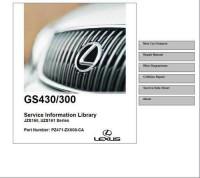
сборник руководств на английском языке по техническому обслуживанию и ремонту + электросхемы автомобилей Lexus GS300/430 в кузовах JZS160 и UZS161.
- Автор: —
- Издательство: Toyota Motor Corporation
- Год издания: —
- Страниц: —
- Формат: ISO
- Размер: 188,4 Mb
Руководство на английском языке по техническому обслуживанию и ремонту автомобилей Lexus GS300/400 1998 года выпуска.
- Автор: —
- Издательство: Toyota Motor Corporation
- Год издания: —
- Страниц: —
- Формат: PDF
- Размер: 28,4 Mb
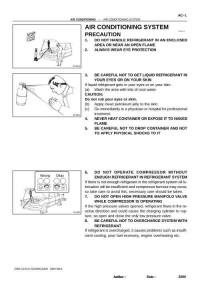
Руководство на английском языке по техническому обслуживанию и ремонту автомобилей Lexus GS300/400 2000 года выпуска.
- Автор: —
- Издательство: Toyota Motor Corporation
- Год издания: —
- Страниц: 1111
- Формат: PDF
- Размер: 16,1 Mb
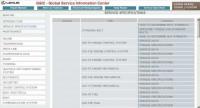
Руководство на английском языке по техническому обслуживанию и ремонту автомобилей Lexus GS300/430 2005 года выпуска.
- Автор: —
- Издательство: Toyota Motor Corporation
- Год издания: —
- Страниц: —
- Формат: ISO
- Размер: 222,0 Mb
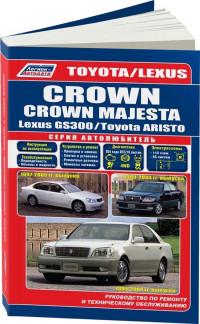
Руководство по эксплуатации, техническому обслуживанию и ремонту автомобилей Lexus GS300/Toyota Aristo 1997-2005 и Toyota Crown/Crown Majesta 1999-2004 годов выпуска.
- Автор: —
- Издательство: Легион-Автодата
- Год издания: —
- Страниц: 496
- Формат: —
- Размер: —

Руководство по эксплуатации и техническому обслуживанию автомобилей Lexus GS300/430 и Toyota Aristo с 2004 года выпуска.
- Автор: —
- Издательство: MoToR
- Год издания: —
- Страниц: 500
- Формат: —
- Размер: —
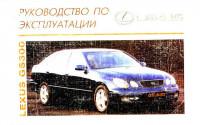
Руководство по эксплуатации и техническому обслуживанию автомобиля Lexus GS300.
- Автор: —
- Издательство: Toyota Motor Corporation
- Год издания: 1998
- Страниц: 197
- Формат: PDF
- Размер: 28,4 Mb
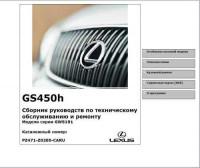
Cборник руководств по техническому обслуживанию и ремонту + электросхемы автомобиля Lexus GS450h в кузове GWS191.
- Автор: —
- Издательство: Toyota Motor Corporation
- Год издания: —
- Страниц: —
- Формат: ISO
- Размер: 62,6 Mb
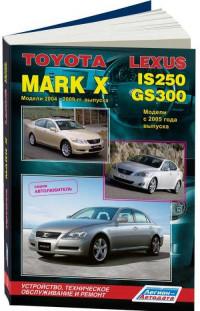
Руководство по техническому обслуживанию и ремонту автомобилей Lexus GS300, IS250 с 2005 и Toyota Mark X 2004-2009 годов выпуска.
- Автор: —
- Издательство: Легион-Автодата
- Год издания: —
- Страниц: 448
- Формат: —
- Размер: —
Trending: ABS, стекло
Page 1 of 700
Page 2 of 700
Page 3 of 700
Page 4 of 700
Page 5 of 700
Page 6 of 700
Page 7 of 700
Page 8 of 700
Page 9 of 700
Page 10 of 700
- Load next 10 pages
Trending: стекло, ABS
View, print and download for free: Lexus GS300h 2016 Инструкция по эксплуатации (in Russian), 700 Pages. Search in Lexus GS300h 2016 Инструкция по эксплуатации (in Russian) online. CarManualsOnline.info is the largest online database of car user manuals. Lexus GS300h 2016 Инструкция по эксплуатации (in Russian) PDF Download.
All product names, logos, and brands are property of their respective owners.
Privacy Policy | About Us & Contact

SECTION 7
REPORTING SAFETY DEFECTS
FOR U.S. OWNERS
Reporting safety defects for U.S. owners
Reporting safety defects for U.S. owners . . . . . . . . . . . . . . . . . . . . . . . . . . . . . . . . . . . . . . . . . . . . . . 598
597

REPORTING SAFETY DEFECTS FOR U.S. OWNERS
REPORTING SAFETY DEFECTS
FOR U.S. OWNERS
If you believe that your vehicle has a defect which could cause a crash or could cause injury or death, you should immediately inform the National Highway Traffic Safety Administration (NHTSA) in addition to notifying Toyota Motor Sales, U.S.A., Inc. (Toll-free: 1-800-25-LEXUS).
If NHTSA receives similar complaints, it may open an investigation, and if it finds that a safety defect exists in a group of vehicles, it may order a recall and remedy campaign. However, NHTSA cannot become involved in individual problems between you, your dealer, or Toyota Motor Sales, U.S.A., Inc.
To contact NHTSA, you may either call the Auto Safety Hotline tollfree at 1- 800424- 9393 (or 366-0123 in Washington, D.C. area) or write to: NHTSA, U.S. Department of Transportation, Washington, D.C. 20590. You can also obtain other information about motor vehicle safety from the Hotline.
598

SECTION 6 ± 5
SERVICE PROCEDURES AND
SPECIFICATIONS
Body
Specifications . . . . . . . . . . . . . . . . . . . . . . . . . . . . . . . . . . . . . . . . . . . . . . . . . . . . . . . . . . . . . . . . . . . . . 590 Protecting your vehicle from corrosion . . . . . . . . . . . . . . . . . . . . . . . . . . . . . . . . . . . . . . . . . . . . . . . . 591 Washing and waxing . . . . . . . . . . . . . . . . . . . . . . . . . . . . . . . . . . . . . . . . . . . . . . . . . . . . . . . . . . . . . . . . 592 Cleaning the interior . . . . . . . . . . . . . . . . . . . . . . . . . . . . . . . . . . . . . . . . . . . . . . . . . . . . . . . . . . . . . . . . 594
589

BODY
SPECIFICATIONS
— DIMENSIONS AND WEIGHT
|
Overall length |
4825 mm (189.9 in.) |
|
Overall width |
1820 mm (71.6 in.) |
|
Overall height |
1425 mm (56.1 in.)* |
|
Two-wheel drive models |
|
|
Four-wheel drive models |
1435 mm (56.4 in.)* |
|
Wheelbase |
2850 mm (112.2 in.) |
|
Tread ± Front |
1535 mm (60.4 in.) |
|
± Rear |
1540 mm (60.6 in.) |
|
Vehicle capacity weight (occupants + luggage) |
370 kg (815 lb.) |
|
*Unladen vehicle |
|
|
— FUEL TANK |
|
|
Capacity |
71 L (18.7 gal., 15.6 lmp.gal.) |
590

BODY
PROTECTING YOUR VEHICLE
FROM CORROSION
Proper care of your Lexus can help ensure longterm corrosion prevention.
The most common causes of corrosion to your vehicle are:
The accumulation of road salt, dirt and moisture in hard-to-reach areas under the vehicle.
Chipping of paint or undercoating caused by minor accidents or by stones and gravel.
The following conditions will cause or accelerate corrosion of your vehicle, so it is important to keep your vehicle, particularly the underside, as clean as possible and to repair any damage to paint or protective coatings as soon as possible.
The presence of road salt or dust control chemicals, salt in the air near the sea coast, industrial air pollution.
High humidity, especially at temperatures just above freezing point.
Certain parts of your vehicle are wet or damp for an extended period of time, even though other parts of the
vehicle are dry.
Components of the vehicle which do not dry quickly due to lack of proper ventilation are exposed to high ambient
temperature.
To help prevent corrosion on your Lexus, follow these guidelines:
Keep your vehicle clean by regular washing. In addition, observe the following points.
If you drive on salted roads in the winter or if you live near the ocean, you should hose off the undercarriage at least
once a month to minimize corrosion.
High pressure water or steam is effective for cleaning the vehicle’s underside and wheel housings. Pay particular attention to these areas as it is difficult to see all the mud and dirt. It will do more harm than good to simply wet the mud and debris without removing them. The lower edge of doors, rocker panels and frame members have drain holes which should not be allowed to clog with dirt as trapped
water in these areas can cause corrosion.
Wash the underside of the vehicle thoroughly when winter is over.
See ºWashing and waxingº on page 592 for more tips.
Check the condition of your vehicle’s paint and trim. If you find any chips or scratches in the paint, touch them up immediately to prevent corrosion from starting. If the chips or scratches have gone through the bare metal, have a qualified body shop make the repair.
591

BODY
Check the interior of your vehicle. Water and dirt can accumulate under the floor mats and could cause corrosion. Occasionally check under the mats to make sure the area is dry. Be particularly careful when transporting chemicals, cleansers, fertilizers, salt, etc. These should be transported in proper containers. If a spill or leak should occur, immediately clean and dry the area.
Keep your vehicle in a well ventilated garage or a roofed place. Do not park your vehicle in a damp, poorly ventilated garage. If you wash your vehicle in the garage, or if you drive it covered with water or snow, your garage may be so damp as to cause corrosion. Even if your garage is heated, a wet vehicle can corrode if the ventilation is poor.
WASHING AND WAXING
Washing your Lexus
Keep your vehicle clean by regular washing.
The following cases may cause weakness to the paint or corrosion to the body and parts. Wash your vehicle as soon as possible.
When driving in a coastal area
When driving on a road sprinkled with antifreeze
When exposed to coal tar, tree sap, bird droppings and carcass of an insect
When driving in areas where there is a lot of smoke, soot, dust, iron dust or chemical substances
When the vehicle becomes remarkably dirty with dust and mud
Hand-washing your Lexus
Work in the shade and wait until the vehicle body is not hot to the touch.
1.Rinse off loose dirt with a hose. Remove any mud or road salt from the underside of the vehicle or the wheel wells.
2.Wash with a mild car-wash soap, mixed according to the manufacturer’s instructions. Use a soft cotton mitt and keep it wet by dipping it frequently into the wash water. Do not rub hard — let the soap and water remove the dirt.
592

BODY
Fuel filler door: Do not apply water (high-pressure car wash, for example) at or near the fuel tank inlet with the fuel filler door opened. If the water enters the air vent, you may experience trouble with refueling or rough engine idling.
Plastic wheel ornaments: The plastic wheel ornaments are damaged easily by organic substances. If any organic substances splash an ornament, be sure to wash them off with water and check if the ornament is damaged.
Aluminum wheels: Use only a mild soap or neutral detergent.
Plastic bumpers and side moldings: Wash carefully. Do not scrub with abrasive cleaners. The bumper and side molding faces are soft.
Exterior lights: Wash carefully. Do not use organic substances or scrub them with a hard brush. This may damage the surfaces of the lights.
Road tar: Remove with turpentine or cleaners that are marked safe for painted surfaces.
3.Rinse thoroughly — dried soap can cause streaking. In hot weather you may need to rinse each section right after you wash it.
4.To prevent water spots, dry the vehicle using a clean soft cotton towel. Do not rub or press hard — you might scratch the paint.
NOTICE
Do not use organic substances (gasoline, kerosene, benzine or strong solvents), which may be toxic or cause damage.
Do not scrub any part of the vehicle with a hard brush, which may cause damage.
Automatic car wash
Your vehicle may be washed in an automatic car wash, but remember that the paint can be scratched by some types of brushes, unfiltered washing water, or the washing process itself. Scratching reduces paint durability and gloss, especially on darker colors. The manager of the car wash should be able to advise you whether the process is safe for the paint on your vehicle.
Waxing your Lexus
Polishing and waxing is recommended to maintain the original beauty of your Lexus’ finish.
Apply wax once a month or if the vehicle surface does not repel water well.
1.Always wash and dry the vehicle surface before you begin waxing, even if you are using a combined cleaner and wax.
2.Use a good quality polish and wax. If the finish has become extremely weathered, use a car-cleaning polish, followed by a separate wax. Carefully follow the manufacturer’s instructions and precautions. Be sure to polish and wax the chrome trim as well as the paint.
593

BODY
3. Wax the vehicle again when water does not bead but remains on the surface in large patches.
Exterior lights: Do not apply wax on the surfaces of the lights. Wax may cause damage to the lenses. If you accidentally put wax on the light surfaces, wipe or wash it off.
CLEANING THE INTERIOR
CAUTION
Be careful not to splash water or spill liquid on the floor. This may prevent the SRS side airbags from activating correctly, resulting in serious injury.
Do not wash the vehicle floor with water, or allow water to get onto the floor when cleaning the vehicle interior or exterior. Water may get into audio components or other electrical components above or under the floor carpet (or mat) and cause a malfunction; and it may cause body corrosion.
Leather-trimmed interior
The selected leather is used in your Lexus. Due to characteristics of leather products, some parts of leather may be rough, uneven or scratched originally.
To keep good appearance, we recommend you to clean it periodically twice a year.
Remove dirt on the leather in the following ways:
1.Wipe it off lightly using a soft cloth (e.g. gauze) dampened with 5% solution of neutral detergent for wool.
2.Wring water from a clean cloth and thoroughly wipe off all traces of detergent with it.
594

BODY
3. Wipe off the surface of the leather with a dry soft cloth. Allow the leather to dry in a ventilated shaded area. Excess of wet may cause the hardening or shrinking of the leather.
NOTICE
Dirt or sand adhered to the leather may damage the treated surface and cause it to wear earlier. Remove dirt or sand using a vacuum cleaner.
If a stain should fail to come out with a neutral detergent, apply a cleaner that does not contain an organic solvent.
Never use organic substances such as benzine, alcohol or gasoline, or alkaline or acid solutions for cleaning the leather as these could cause discoloring.
Use of a nylon brush or synthetic fiber cloth, etc. may scratch the fine grained surface of the leather.
Mildew may develop on soiled leather upholstery. Be especially careful to avoid oil spots. Try to keep your upholstery always clean.
Long exposure to direct sunlight may cause the leather surface to harden and shrink. Keep your vehicle in a shaded area, especially in the summer.
The interior of your vehicle is apt to heat up on hot summer days, so avoid placing on the upholstery items made of vinyl or plastic or containing wax as these tend to stick to leather when warm.
Improper cleaning of the leather upholstery could result in discoloration or staining.
Non-leather trim (Dash and sun visors)
The non-leather trim may be easily cleaned with a mild soap or detergent and water.
First vacuum over the upholstery to remove loose dirt. Then, using a sponge or soft cloth, apply the soap solution to the non-leather trim. After allowing it to soak in for a few minutes to loosen the dirt, remove the dirt and wipe off the soap with a clean damp cloth. If all the dirt does not come off, repeat the procedure. Commercial foamingtype cleaners are also available which work well. Follow the manufacturer’s instructions.
NOTICE
Do not use solvent, thinner, gasoline or window cleaner on the interior.
595

BODY
Carpets, Windows and Seat Belts
Begin by vacuuming thoroughly to remove as much dirt as possible. Several types of foam cleaners are available; some are in aerosol cans and others are powders or liquids which you mix with water to produce a foam. To shampoo the carpets, use a sponge or brush to apply the foam. Rub in overlapping circles. Do not apply water — the best results are obtained by keeping the carpet as dry as possible. Read the shampoo instructions and follow them closely.
The seat belts may be cleaned with mild soap and water or with lukewarm water.
Use a cloth or sponge. As you are cleaning, check the belts for excessive wear, fraying or cuts.
NOTICE
Use a good foam-type shampoo to clean the carpets.
Do not use dye or bleach on the belts — it may weaken them.
Do not use the belts until they become dry.
The windows may be cleaned with any household window cleaner.
When cleaning the inside of the rear window, be careful not to scratch or damage the heater wires.
Air Conditioning Control Panel, Audio
System, Instrument Panel, Console Panel,
and Switches
Use a soft damp cloth for cleaning.
Soak a clean soft cloth in water or lukewarm water then lightly wipe off any dirt.
NOTICE
Do not use organic substances (solvents, kerosene, alcohol, gasoline, etc.) or alkaline or acidic solutions. These chemicals can cause discoloring, staining or peeling of the surface.
If you use cleaners or polishing agents, make sure their ingredients do not include the substances mentioned above.
If you use a liquid car freshener, do not spill the liquid onto the vehicle’s interior surfaces. It may contain the ingredients mentioned above. Immediately clean any spill using the method mentioned above.
If you have any questions about the cleaning of your Lexus, your local Lexus dealer will be pleased to answer them.
596

SECTION 6 ± 4
SERVICE PROCEDURES AND
SPECIFICATIONS
Electrical components
Specifications . . . . . . . . . . . . . . . . . . . . . . . . . . . . . . . . . . . . . . . . . . . . . . . . . . . . . . . . . . . . . . . . . . . . . 564 Checking battery condition . . . . . . . . . . . . . . . . . . . . . . . . . . . . . . . . . . . . . . . . . . . . . . . . . . . . . . . . . . 571 Battery recharging precautions . . . . . . . . . . . . . . . . . . . . . . . . . . . . . . . . . . . . . . . . . . . . . . . . . . . . . . . 574 Checking and replacing the blade type fuses . . . . . . . . . . . . . . . . . . . . . . . . . . . . . . . . . . . . . . . . . . . 574 Checking the cartridge type fuses . . . . . . . . . . . . . . . . . . . . . . . . . . . . . . . . . . . . . . . . . . . . . . . . . . . . 577 Adding washer fluid . . . . . . . . . . . . . . . . . . . . . . . . . . . . . . . . . . . . . . . . . . . . . . . . . . . . . . . . . . . . . . . . 579 Checking the headlight aim . . . . . . . . . . . . . . . . . . . . . . . . . . . . . . . . . . . . . . . . . . . . . . . . . . . . . . . . . . 579 Replacing light bulbs . . . . . . . . . . . . . . . . . . . . . . . . . . . . . . . . . . . . . . . . . . . . . . . . . . . . . . . . . . . . . . . 584
563
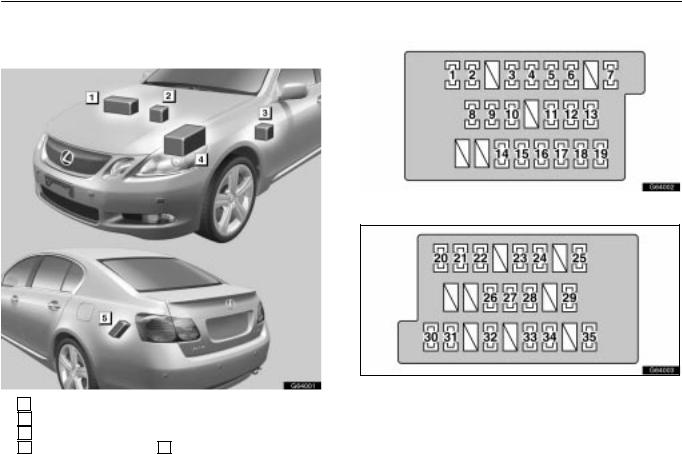
ELECTRICAL COMPONENTS
|
SPECIFICATIONS |
— FUSES |
||
|
— FUSE LOCATION |
|||
Right side kick panel
Left side kick panel
1 Engine compartment
2 Left side kick panel
3 Right side kick panel
4 Engine compartment 5 Trunk
564
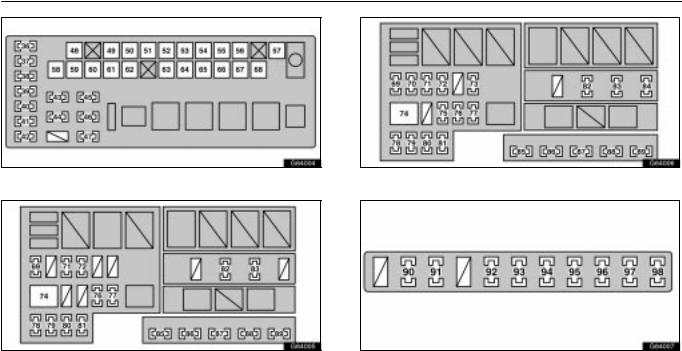
ELECTRICAL COMPONENTS
Engine compartment
Engine compartment (GS430)
Engine compartment (GS300)
Trunk
565

ELECTRICAL COMPONENTS
|
No. |
FUSE |
AMPERE |
CIRCUIT |
|
|
1 |
STR LOCK |
25 |
Steering lock system |
|
|
2 |
SECURITY |
7.5 |
Smart access system with |
|
|
push-button start |
||||
|
3 |
TI &TE |
20 |
Power tilt and telescopic |
|
|
steering wheel, Multiplex |
||||
|
communication system |
||||
|
4 |
AM1 |
7.5 |
Starting system |
|
|
Stop/tail lights, Multi-port fuel |
||||
|
injection system/sequential |
||||
|
5 |
STOP SW |
7.5 |
multiport fuel injection system, |
|
|
Starting system, Electronic |
||||
|
control brake system, Vehicle |
||||
|
stability control system, Shift |
||||
|
lock system |
||||
|
6 |
OBD |
7.5 |
On-board diagnosis system |
|
|
7 |
FR P/SEAT |
30 |
Power seat system |
|
|
RH |
||||
|
8 |
AIR SUS |
20 |
Electronic modulated |
|
|
suspension |
||||
|
9 |
PWR |
15 |
Power outlet |
|
|
OUTLET |
||||
|
10 |
CIG |
15 |
Cigarette lighter |
|
|
Multiplex communication |
||||
|
11 |
ACC |
7.5 |
system, Smart access system |
|
|
with push-button start, Rear |
||||
|
view monitor system, Audio |
||||
|
system, Air conditioning system |
||||
|
No. |
FUSE |
AMPERE |
CIRCUIT |
|
|
Multi-port fuel injection |
||||
|
system/sequential multiport fuel |
||||
|
12 |
IGN |
10 |
injection system, SRS airbag |
|
|
system, Stop/tail lights, |
||||
|
Steering lock system, Electronic |
||||
|
control brake system |
||||
|
13 |
GAUGE |
7.5 |
Gauges and meters |
|
|
Power tilt and telescopic |
||||
|
steering wheel, Multiplex |
||||
|
communication system, Smart |
||||
|
14 |
ECU-IG |
10 |
access system with |
|
|
push-button start, Audio |
||||
|
RH |
||||
|
system, Air conditioning |
||||
|
system, Shift lock system, Tire |
||||
|
pressure warning system, |
||||
|
Combination switch |
||||
|
15 |
FR S/HTR |
15 |
Seat heater, Heated and |
|
|
RH |
ventilated seats |
|||
|
Seat heater switches, Front |
||||
|
right door control system, Rear |
||||
|
16 |
RH-IG |
7.5 |
right door control system, |
|
|
Capacitor, Combination switch, |
||||
|
Seat belt pretensioners, |
||||
|
Intuitive parking assist |
||||
|
17 |
AM2 |
15 |
Starting system |
|
566

ELECTRICAL COMPONENTS
|
No. |
FUSE |
AMPERE |
CIRCUIT |
|
|
Front right door control system |
||||
|
(Power door lock system, |
||||
|
18 |
FR DOOR |
20 |
Power rear view mirror control |
|
|
system, Door courtesy light, |
||||
|
RH |
||||
|
Outside rear view mirror heater, |
||||
|
Power window), Multiplex |
||||
|
communication system |
||||
|
19 |
RR DOOR |
20 |
Rear right door control system |
|
|
(Power door lock system, Door |
||||
|
RH |
||||
|
courtesy light, Power window) |
||||
|
20 |
RR DOOR |
20 |
Rear left door control system |
|
|
(Power door lock system, Door |
||||
|
LH |
||||
|
courtesy light, Power window) |
||||
|
Front left door control system |
||||
|
FR DOOR |
(Power door lock system, |
|||
|
21 |
20 |
Power rear view mirror control |
||
|
LH |
system, Door courtesy light, |
|||
|
Outside rear view mirror heater, |
||||
|
Power window) |
||||
|
22 |
RAD NO.3 |
10 |
Audio system |
|
|
23 |
H-LP LVL |
7.5 |
Adaptive front lighting system |
|
|
(AFS), Automatic headlight |
||||
|
leveling control system |
||||
|
No. |
FUSE |
AMPERE |
CIRCUIT |
|
|
Charging system, Headlight |
||||
|
cleaners, Exhaust gas sensor, |
||||
|
Rear window defogger, Electric |
||||
|
cooling fans, Rear left door |
||||
|
24 |
LH-IG |
10 |
control system, Front left door |
|
|
control system, Emergency |
||||
|
flashers, Automatic |
||||
|
transmission, Seat belt |
||||
|
pretensioners, Intuitive parking |
||||
|
assist |
||||
|
25 |
FR WIP |
30 |
Windshield wipers and washer |
|
|
Steering switch illumination, |
||||
|
Audio system, Glove box light, |
||||
|
Automatic transmission selector |
||||
|
lever illumination, Console box |
||||
|
light, Adaptive variable |
||||
|
suspension switch illumination, |
||||
|
26 |
PANEL |
7.5 |
Cigarette lighter illumination, Air |
|
|
conditioning system, Traction |
||||
|
control off switch illumination, |
||||
|
Driving pattern selector switch, |
||||
|
Seat heater or Heated and |
||||
|
ventilated seat switches, |
||||
|
Register ILL RH, Register ILL |
||||
|
LH, Register ILL CTR |
||||
|
27 |
FUEL |
10 |
Fuel filler door opener, Trunk lid |
|
|
OPEN |
opener |
|||
567

ELECTRICAL COMPONENTS
|
No. |
FUSE |
AMPERE |
CIRCUIT |
|
|
Vehicle stability control system, |
||||
|
Electronic control brake system, |
||||
|
Yaw rate and G sensor, |
||||
|
Steering sensor, Cruise control |
||||
|
system, Dynamic radar cruise |
||||
|
28 |
ECU-IG LH |
10 |
control system, Electronic |
|
|
power steering system, Variable |
||||
|
gear ratio steering system, |
||||
|
Rear view monitor system, |
||||
|
Four-wheel drive system, Front |
||||
|
controller, Moon roof, Rain |
||||
|
sensor |
||||
|
29 |
FR S/HTR |
15 |
Seat heater, Heated and |
|
|
LH |
ventilated seats |
|||
|
30 |
FR P/SEAT |
30 |
Power seat system |
|
|
LH |
||||
|
31 |
A/C |
7.5 |
Air conditioning system |
|
|
32 |
TV |
7.5 |
Audio system, Air conditioning |
|
|
system, Rear view monitor |
||||
|
system |
||||
|
33 |
TRK OPN |
10 |
Trunk lid opener |
|
|
34 |
LH-B |
10 |
Theft deterrent system |
|
|
35 |
S/ROOF |
25 |
Moon roof |
|
|
Variable gear ratio steering |
||||
|
36 |
ECU-B |
10 |
system, Electronic power |
|
|
steering system, Driver’s seat |
||||
|
switch module |
||||
|
37 |
ABS |
10 |
Electronic control brake system |
|
|
MAIN3 |
||||
|
No. |
FUSE |
AMPERE |
CIRCUIT |
|
|
38 |
TURN-HAZ |
15 |
Turn signal lights, Emergency |
|
|
flashers |
||||
|
39 |
IG2 MAIN |
20 |
“IG2º, “GAUGEº and “IGNº |
|
|
40 |
RAD NO.2 |
30 |
Audio system |
|
|
41 |
D/C CUT |
20 |
“DOME “ and “MPX-Bº |
|
|
42 |
RAD NO.1 |
30 |
Audio system |
|
|
Multiplex communication |
||||
|
system, Front controller, Door |
||||
|
control system (Power door |
||||
|
lock system, Door courtesy |
||||
|
lights, Power windows, Power |
||||
|
43 |
MPX-B |
10 |
rear view mirror control system, |
|
|
Outside rear view mirror |
||||
|
heaters), Power seat system, |
||||
|
Steering sensors, Electronic |
||||
|
control brake system, Power tilt |
||||
|
and telescopic steering system, |
||||
|
Gauges and meters, |
||||
|
Combination switch |
||||
|
Foot lights, Vanity lights, |
||||
|
Gauges and meters, Steering |
||||
|
44 |
DOME |
10 |
spot light, Steering switch |
|
|
illumination, Rear personal |
||||
|
lights, Automatic transmission |
||||
|
selector lever spot light, Front |
||||
|
personal lights |
||||
|
45 |
ABS |
10 |
Electronic control brake system |
|
|
MAIN2 |
||||
|
46 |
ABS |
30 |
Anti-lock brake system |
|
|
MOTOR |
||||
568

ELECTRICAL COMPONENTS
|
No. |
FUSE |
AMPERE |
CIRCUIT |
|
|
47 |
ABS |
10 |
Capacitor |
|
|
MAIN1 |
||||
|
48 |
E/G-B |
60 |
“FR CTRL BATTº, “ETCSº and |
|
|
“ALT-Sº |
||||
|
49 |
ABS1 |
50 |
Vehicle stability control system, |
|
|
“ABS MAIN1º, “ABS MAIN2º |
||||
|
and “ABS MTRº |
||||
|
50 |
RH J/B-B |
30 |
“AM2º, “DOOR FRº and “DOOR |
|
|
RRº |
||||
|
51 |
VGRS |
40 |
Variable gear ratio steering |
|
|
system |
||||
|
52 |
MAIN |
30 |
“H-LP R LWRº and “H-LP L |
|
|
LWRº |
||||
|
53 |
STARTER |
30 |
Starting system |
|
|
54 |
LH J/B-B |
30 |
“FL DOORº, “RL DOORº and |
|
|
“RAD No.3º |
||||
|
55 |
P/I-B |
60 |
Multi-port fuel injection |
|
|
system/sequential multiport fuel |
||||
|
injection system |
||||
|
56 |
EPS |
80 |
Electronic power steering |
|
|
system |
||||
|
“RH J/B-AMº, “LH J/B-AMº, |
||||
|
57 |
ALT |
150 |
“E/G-AMº, “RR JBº, “HEATERº, |
|
|
“DEFOGº, “FAN1º, “FAN2º, |
||||
|
“ABS2º, “ABS MOTORº, “ABS |
||||
|
MAIN1º, and “ABS MAIN2º |
||||
|
No. |
FUSE |
AMPERE |
CIRCUIT |
|
|
“STOP LP Rº, “STOP LP Lº, |
||||
|
58 |
RR J/B |
80 |
“RR-Bº, “RR TAILº, “RR FOGº, |
|
|
“RR-IG1º, “PSBº, and “RR |
||||
|
S/SHADEº |
||||
|
59 |
GLW PLG1 |
50 |
Glow plug heater |
|
|
“AM1º, “OBDº, “STOP SWº, “TI |
||||
|
&TEº, “PWR OUTLETº, “FR |
||||
|
60 |
RH J/B-AM |
80 |
P/SEAT RHº, “STR LOCKº, |
|
|
“ECU-IG RHº, “RH-IGº, “ACCº, |
||||
|
“CIGº, “SECURITYº, “FR |
||||
|
S/HTR RHº, and “AIR SUSº |
||||
|
61 |
ABS2 |
30 |
Vehicle stability control system, |
|
|
Anti-lock brake system |
||||
|
62 |
DEFOG |
50 |
Rear window defogger, Noise |
|
|
filter |
||||
|
63 |
FAN1 |
40 |
Electric cooling fans |
|
|
64 |
HEATER |
50 |
Air conditioning system |
|
|
65 |
GLW PLG2 |
50 |
Glow plug heater |
|
|
66 |
E/G-AM |
60 |
“H-LMP CLNº, “FR CTRL-AMº |
|
|
and “A/C COMPº |
||||
|
“S/ROOFº, “FR P/SEAT LHº, |
||||
|
67 |
LH J/ |
80 |
“TVº, “FR S/HTR LHº, “ECU-IG |
|
|
LHº, “FR WIPº, “H-LP LVLº, |
||||
|
B-AM |
||||
|
“LH-IGº, “FUEL OPENº, “A/Cº, |
||||
|
“PANELº, and “LH-Bº |
||||
|
68 |
FAN2 |
60 |
No circuit |
|
|
69 |
FR |
25 |
“H-LP UPRº and “HORNº |
|
|
CTRL-B |
||||
569

ELECTRICAL COMPONENTS
|
No. |
FUSE |
AMPERE |
CIRCUIT |
|
|
70 |
A/F |
15 |
Multi-port fuel injection |
|
|
system/sequential multiport fuel |
||||
|
injection system |
||||
|
71 |
ETCS |
10 |
Multi-port fuel injection |
|
|
system/sequential multiport fuel |
||||
|
injection system |
||||
|
72 |
ALT-S |
7.5 |
Charging system |
|
|
73 |
EM VLV |
10 |
No circuit |
|
|
74 |
H-LP CLN |
30 |
Headlight cleaner system |
|
|
75 |
A/C COMP |
7.5 |
Air conditioning system |
|
|
76 |
DEICER |
25 |
No circuit |
|
|
77 |
FR |
30 |
“FR TAILº, “FR FOGº and |
|
|
CTRL-AM |
“WASHERº |
|||
|
78 |
IG2 |
10 |
Starting system |
|
|
Multi-port fuel injection |
||||
|
79 |
EFI NO.2 |
10 |
system/sequential multiport fuel |
|
|
injection system, Evaporative |
||||
|
system |
||||
|
80 |
H-LP R |
15 |
Right-hand headlight (low |
|
|
LWR |
beam) |
|||
|
81 |
H-LP L |
15 |
Left-hand headlight (low beam) |
|
|
LWR |
||||
|
82 |
F/PMP |
25 |
Fuel pump |
|
|
No. |
FUSE |
AMPERE |
CIRCUIT |
|
|
GS430: |
Multi-port fuel injection |
|||
|
83 |
EFI |
25 |
system/sequential multiport fuel |
|
|
GS300: |
injection system |
|||
|
25 |
||||
|
84 |
INJ |
20 |
Multi-port fuel injection |
|
|
system/sequential multiport fuel |
||||
|
injection system |
||||
|
85 |
H-LP UPR |
15 |
Headlights (high beam) |
|
|
86 |
HORN |
10 |
Horn |
|
|
87 |
WASHER |
20 |
Windshield wipers and washer |
|
|
88 |
FR TAIL |
10 |
Parking lights, Side marker |
|
|
lights |
||||
|
89 |
FR FOG |
15 |
Front fog lights |
|
|
90 |
RR |
7.5 |
Rear electric sunshade |
|
|
S/SHADE |
||||
|
91 |
PSB |
30 |
Pre-collision system |
|
|
92 |
RR-IG2 |
10 |
No circuit |
|
|
93 |
RR-IG1 |
10 |
Pre-collision system, Rear |
|
|
electric sunshade, Seat belt |
||||
|
pretensioners |
||||
|
94 |
RR-B |
10 |
Luggage compartment light, |
|
|
Noise filter |
||||
|
95 |
RR FOG |
7.5 |
Rear fog lights |
|
|
96 |
STOP LP L |
10 |
Stoplights, Back up lights |
|
570

ELECTRICAL COMPONENTS
|
No. |
FUSE |
AMPERE |
CIRCUIT |
|
|
97 |
STOP LP R |
10 |
High mounted stoplights |
|
|
98 |
RR TAIL |
10 |
License plate lights, Tail lights, |
|
|
Rear side marker lights |
||||
CHECKING BATTERY CONDITION
Precautions
CAUTION
BATTERY PRECAUTIONS
The battery produces flammable and explosive hydrogen gas.
Do not cause a spark by contacting the battery terminals with tools.
Do not smoke or light a match near the battery.
The electrolyte contains poisonous and corrosive sulfuric acid.
Avoid contact with eyes, skin or clothes.
Never inhale or swallow electrolyte.
Wear protective safety glasses when working near the battery.
Keep children away from the battery.
EMERGENCY MEASURES
If electrolyte gets in your eyes, flush your eyes with clean water for at least 15 minutes and get immediate medical attention. If possible, continue to apply water with a sponge or cloth while traveling to the medical office.
571

ELECTRICAL COMPONENTS
If electrolyte gets on your skin, thoroughly wash the contacted area. If you feel a pain or burn, get medical attention immediately.
If electrolyte gets on your clothes, there is a possibility of its soaking through to your skin, so immediately take off the exposed clothing and follow the procedure above, if necessary.
If you accidentally swallow electrolyte, drink a large quantity of water or milk. Follow with milk of magnesia, beaten raw egg or vegetable oil. Then go immediately for emergency help.
Checking battery exterior
1 Terminals 2 Hold-down clamp
Check the battery for corroded or loose connections, cracks, or loose hold-down clamps.
1.If the battery is corroded, wash it off with a solution of warm water and baking soda. Coat the terminals with grease to prevent further corrosion.
2.If the connections are loose, tighten the clamp bolts — but do not overtighten.
3.Tighten the holddown clamp only enough to keep the battery firmly in place. Overtightening may damage the battery case.
572
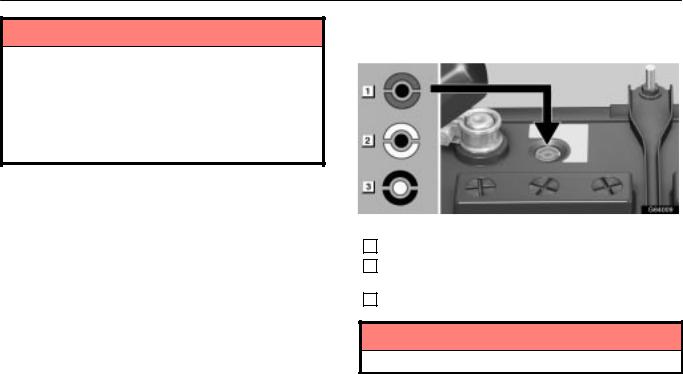
ELECTRICAL COMPONENTS
NOTICE
Make sure the engine and all accessories are turned off before performing maintenance.
When checking the battery, remove the ground cable first and reinstall it last.
Be careful not to cause a short circuit with tools.
Take care no solution gets into the battery when washing it.
If the battery is disconnected or run down
The following functions may not operate correctly when you reconnect or replace the battery. In these cases, you should normalize each system referring to the following pages.
Power windows (See page 59.)
Moon roof (See page 134.)
Variable gear ratio steering system (See page 424.)
Intuitive parking assist (See page 380.)
Checking battery condition
Checking by indicator
Check the battery condition by the indicator color.
1BLUE — Good condition.
2WHITE — Charging necessary. Have the battery checked by your Lexus dealer.
3RED — Have the battery checked by your Lexus dealer.
NOTICE
Do not refill the battery with water.
573

ELECTRICAL COMPONENTS
BATTERY RECHARGING
PRECAUTIONS
During recharging, the battery is producing hydrogen gas.
Therefore, before recharging:
1.If recharging with the battery installed on the vehicle, be sure to disconnect the ground cable.
2.Make sure the power switch on the recharger is off when connecting the charger cables to the battery and when disconnecting them.
CAUTION
Always charge the battery in an unconfined area. Do not charge the battery in a garage or closed room where there is not sufficient ventilation.
Only do a slow charge (5 A or less). Charging at a quicker rate is dangerous. The battery may explode causing personal injuries.
NOTICE
Never recharge the battery while the engine is running. Also, be sure all accessories are turned off.
CHECKING AND REPLACING THE
BLADE TYPE FUSES
Left side kick panel
Right side kick panel
574

ELECTRICAL COMPONENTS
|
Engine compartment |
Trunk |
|
|
1. Turn the engine switch off and open the fuse box lid. |
||
|
Determine which fuse may be causing the problem. The lid of |
||
|
the fuse box shows the name of the circuit for each fuse. |
||
Engine compartment 1 Pull-out tool 2 Spare fuses
575

ELECTRICAL COMPONENTS
2. Make sure the inoperative component is turned off. Pull the suspected fuse straight out with the pull-out tool and check it. If it has blown, push a new fuse into the clips.
a.Look carefully at the fuse. If the thin wire is broken, the fuse has blown. If you are not sure or if it is too dark to see, try replacing the suspected fuse with one of the same value that you know is good.
b.Install only a fuse with the amperage rating designated on the fuse box lid.
If you do not have a spare fuse, in an emergency you can pull out the ºCIGº, ºRAD NO.1º or ºOBDº fuse, which may be dispensable for normal driving, and use it if its amperage rating is the same.
If you cannot use one of the same amperage, use one lower than, but as close to the amperage as possible. If the amperage is lower than that specified, the fuse might blow out again but this does not indicate anything wrong. Be sure to get the correct fuse as soon as possible and return the substitute to its original clips.
576

ELECTRICAL COMPONENTS
It is a good idea to purchase a set of spare fuses and keep them in your vehicle for emergencies.
If the new fuse immediately blows out, there is a problem with the electrical system. Have your Lexus dealer correct it as soon as possible.
CAUTION
Never use a fuse with a higher amperage rating, or any other object, in place of a fuse. This may cause extensive damage and possibly a fire.
CHECKING THE CARTRIDGE TYPE
FUSES
Engine compartment
577
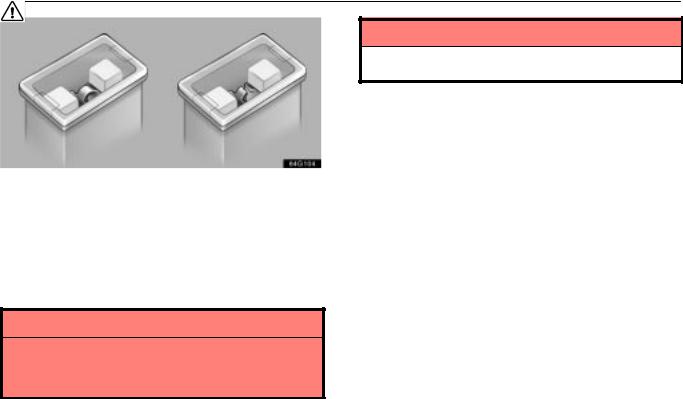
ELECTRICAL COMPONENTS
NOTICE
Before replacing the fuses, have the cause of electrical overload determined and repaired by your Lexus dealer.
If the headlights or other electrical components do not work and the blade type fuses are O.K., check the cartridge type fuses. If any of the cartridge type fuses are blown, they must be replaced.
If there is an overload in the circuits from the battery, the fuses are designed to blow before the entire wiring harness is damaged.
CAUTION
Always use a genuine Lexus fuse or equivalent for replacement. Never install an ordinary wire — even for a temporary fix. This may cause extensive damage and possibly a fire.
578
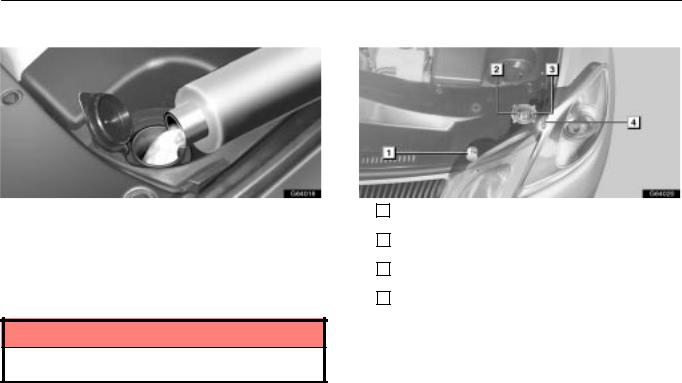
ELECTRICAL COMPONENTS
|
ADDING WASHER FLUID |
CHECKING THE HEADLIGHT AIM |
||
If the washer tank becomes nearly empty, add washer fluid.
You may use plain water as washer fluid. However, in cold areas where temperatures range below the freezing point, use washer fluid containing antifreeze. This product is available at your Lexus dealer and most auto parts stores. Follow the manufacturer’s directions for how much to mix with water.
NOTICE
Do not use engine antifreeze or any other substitute because it may damage your vehicle’s paint.
|
1 |
Beam angle gauge |
|
(horizontal movement for high beam) |
|
|
2 |
Beam angle gauge |
|
(vertical movement for high beam) |
|
|
3 |
Beam angle gauge |
|
(vertical movement for low beam) |
|
|
4 |
Beam angle gauge |
|
(horizontal movement for low beam) |
Before checking the headlight aim:
1.Be sure that the body around the headlight is not deformed.
2.Park the vehicle on a level spot.
3.The driver gets into the driver’s seat and puts the vehicle in a state readying for a driving (with a full tank).
4.Bounce the vehicle several times.
579
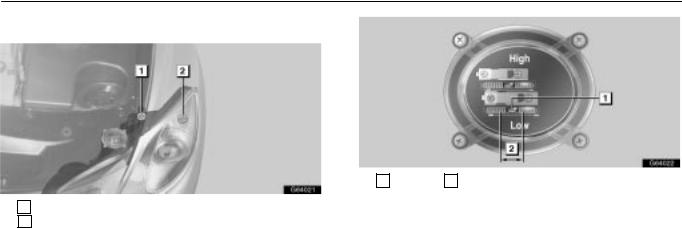
ELECTRICAL COMPONENTS
Adjusting the headlight aiming (low beam)
1 Adjusting bolt A
2 Adjusting bolt B
1 Bubble 2 Acceptable range
Vertical movement gauge: The bubble of the gauge should not deviate from the center of the gauge by more than 2 marks to either side of the gauge.
If the bubble is out of the acceptable range of the beam angle gauge, adjust it using bolt A and B.
580

ELECTRICAL COMPONENTS
1. Turn the bolt A in either direction using a Phillips-head screwdriver. At this time, keep the turning direction and number of turns in mind.
2. Turn the bolt B the same number of turns and in the same direction as step 1 using a Phillips-head screwdriver.
If you do not know or cannot find the original position, or if you feel that there is a large deviation, take the vehicle to your Lexus dealer to adjust the headlight aim.
After adjusting the headlight in the vertical direction, check that the light has been shifted from the adjusted position in the horizontal direction.
581
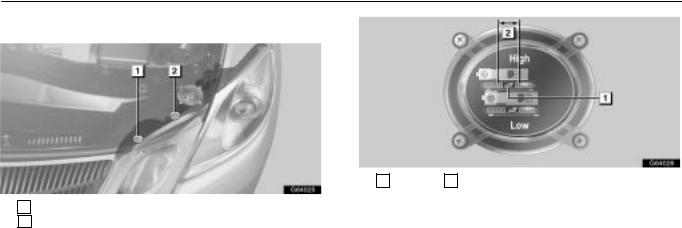
ELECTRICAL COMPONENTS
Adjusting the headlight aiming (high beam)
1 Adjusting bolt A
2 Adjusting bolt B
1 Bubble 2 Acceptable range
Vertical movement gauge: The bubble of the gauge should not deviate from the center of the gauge by more than 2 marks to either side of the gauge.
If the bubble is out of the acceptable range of the beam angle gauge, adjust it using bolt A.
582

ELECTRICAL COMPONENTS
Turn the bolt A in either direction using a Phillipshead screwdriver.
1 Red line 2 Acceptable range
Horizontal movement gauge: The red line should not deviate by more than 2 blue lines to either side of the gauge.
If the red line is out of the acceptable range of the beam angle gauge, adjust it using bolt B.
583

ELECTRICAL COMPONENTS
Turn the bolt B in either direction using a Phillipshead screwdriver.
If you do not know or cannot find the original position, or if you feel that there is a large deviation, take the vehicle to your Lexus dealer to adjust the headlight aim.
REPLACING LIGHT BULBS
The illustrations on the following pages show the locations of light bulbs. If it is necessary to replace a bulb, take your vehicle to your Lexus dealer as soon as possible. Use bulbs with the bulb numbers and wattage ratings given in the table.
The tail lights, stop lights, high mounted stoplight and rear side marker light consist of a number of LEDs. If any LED burns out, we recommend you take your vehicle to your Lexus dealer to have the light inspected as soon as possible.
CAUTION
To prevent burning yourself, do not replace the light bulbs while they are hot.
Halogen bulbs have pressurized gas inside and require special handling. They can burst or shatter if scratched or dropped. Hold a bulb only by its plastic or metal case. Do not touch the glass part of a bulb with bare hands.
Do not touch the high voltage socket when the headlights turn on. 20000 V is momentarily generated and may cause severe injury by electric shock.
Do not disassemble, repair or take apart the headlight bulbs, connector, power supply circuits and rotated components. Or you may be injured by electric shock. Call your dealer when the headlights fail to work or have to be replaced or disposed of.
584

ELECTRICAL COMPONENTS
LIGHT LOCATION
NOTICE
Only use a bulb of the listed type.
The inside of the lens of exterior lights such as headlights may temporarily fog up when the lens becomes wet in the rain or in a car wash. This is not a problem because the fogging is caused by the temperature difference between the outside and inside of the lens, just like the windshield fogs up in the rain. However, if there is a large drop of water on the inside of the lens, or if there is water pooled inside the light, contact your Lexus dealer.
|
Light Bulbs |
Bulb No. |
W |
Type |
|
|
1 |
Headlight (High beam) |
HB3 |
60 |
A |
|
2 |
Parking light |
— |
5 |
D |
|
3 |
Front turn signal light |
— |
21 |
E |
|
4 |
Headlight (Low beam) |
D4S |
35 |
B |
|
5 |
Front side marker light |
194 |
5 |
D |
|
6 |
Fog light |
HB4 |
51 |
C |
585

ELECTRICAL COMPONENTS
|
Light Bulbs |
Bulb No. |
W |
Type |
Light Bulbs |
Bulb No. |
W |
Type |
||
|
1 |
High mounted stoplight |
— |
3.6 |
G |
1 |
Front interior lights |
— |
0.1 |
G |
|
2 |
Tail light |
— |
0.9/0.5 |
G |
2 |
Front seat spot lights |
— |
0.1 |
G |
|
3 |
Tail/stop light |
— |
0.9/10.8 |
G |
3 |
Vanity lights |
— |
8 |
D |
|
4 |
Trunk light |
— |
5 |
F |
4 |
Rear seat spot lights |
— |
0.2 |
G |
|
5 |
Rear side marker light |
— |
0.5 |
G |
5 |
Door courtesy lights |
— |
0.2 |
G |
|
6 |
Rear turn signal light |
— |
21 |
E |
6 |
Foot lights |
— |
0.2 |
G |
|
7 |
Back-up light |
921 |
16 |
D |
7 |
Glove box light |
— |
0.2 |
G |
|
8 |
License plate light |
— |
0.85 |
G |
586

ELECTRICAL COMPONENTS
A:HB3 halogen bulbs
B:D4S discharge bulbs
C:HB4 halogen bulbs
D:Wedge base bulbs (clear)
E:Wedge base bulbs (amber)
F:Double end bulbs
G:LEDs (Light-emitting Diodes)
587
ELECTRICAL COMPONENTS
588

SECTION 6 ± 3
SERVICE PROCEDURES AND
SPECIFICATIONS
Chassis
Specifications (GS430) . . . . . . . . . . . . . . . . . . . . . . . . . . . . . . . . . . . . . . . . . . . . . . . . . . . . . . . . . . . . . 532 Specifications (GS300) . . . . . . . . . . . . . . . . . . . . . . . . . . . . . . . . . . . . . . . . . . . . . . . . . . . . . . . . . . . . . 535 Checking brake fluid . . . . . . . . . . . . . . . . . . . . . . . . . . . . . . . . . . . . . . . . . . . . . . . . . . . . . . . . . . . . . . . . 538 Checking tire inflation pressure . . . . . . . . . . . . . . . . . . . . . . . . . . . . . . . . . . . . . . . . . . . . . . . . . . . . . . . 539 Tire information . . . . . . . . . . . . . . . . . . . . . . . . . . . . . . . . . . . . . . . . . . . . . . . . . . . . . . . . . . . . . . . . . . . . 542 Run-flat tires . . . . . . . . . . . . . . . . . . . . . . . . . . . . . . . . . . . . . . . . . . . . . . . . . . . . . . . . . . . . . . . . . . . . . . 552 Types of tires . . . . . . . . . . . . . . . . . . . . . . . . . . . . . . . . . . . . . . . . . . . . . . . . . . . . . . . . . . . . . . . . . . . . . . 553 Rotating tires . . . . . . . . . . . . . . . . . . . . . . . . . . . . . . . . . . . . . . . . . . . . . . . . . . . . . . . . . . . . . . . . . . . . . . 554 Checking and replacing tires . . . . . . . . . . . . . . . . . . . . . . . . . . . . . . . . . . . . . . . . . . . . . . . . . . . . . . . . . 554 Installing snow tires and chains . . . . . . . . . . . . . . . . . . . . . . . . . . . . . . . . . . . . . . . . . . . . . . . . . . . . . . 558 Replacing wheels . . . . . . . . . . . . . . . . . . . . . . . . . . . . . . . . . . . . . . . . . . . . . . . . . . . . . . . . . . . . . . . . . . 560 Aluminum wheel precautions . . . . . . . . . . . . . . . . . . . . . . . . . . . . . . . . . . . . . . . . . . . . . . . . . . . . . . . . 561 Suspension and chassis . . . . . . . . . . . . . . . . . . . . . . . . . . . . . . . . . . . . . . . . . . . . . . . . . . . . . . . . . . . . 562
531

CHASSIS
SPECIFICATIONS (GS430)
± DIFFERENTIAL
|
Oil capacity |
1.35 L (1.42 qt., 1.19 lmp.qt.) |
|
Oil type and viscosity |
Toyota Genuine Differential Synthetic gear oil |
|
API GL-5 SAE 75W-90 or its equivalent |
NOTE:
The following label is affixed on the right side of the differential carrier. Use the type and viscosity shown on the label when the differential oil is replaced.
Synthetic oil information label
NOTICE
Use of differential oil other than “Toyota Genuine Differential Synthetic gear oil API GL-5 SAE 75W-90º or its equivalent may damage the differential gear of your vehicle and diminish fuel efficiency. For the reasons mentioned above, Lexus recommends use of “Toyota Genuine Differential Synthetic gear oil API GL-5 SAE 75W-90º. Another differential oil of matching quality can also be used, (but note that despite the similarity in nomenclature between “Toyota Genuine Differential Synthetic gear oil API GL-5 SAE 75W-90º and oils that meet SAE 75W-90 specifications, compliance with the SAE specification does not guarantee that an oil has all characteristic required to avoid the problem described above.) If you are unable to locate an equivalent to “Toyota Genuine Differential Synthetic gear oil API GL-5 SAE 75W-90º, contact your Lexus dealer for further details or another duly qualified and equipped professional.
532

CHASSIS
± AUTOMATIC TRANSMISSION
|
Fluid capacity |
1.7 L (1.5 qt., 1.8 lmp.qt.) |
|
Drain and refill |
|
|
Fluid type |
Toyota Genuine ATF WS* |
*Change automatic transmission fluid only as necessary. Generally, it is necessary to change automatic transmission fluid only if your vehicle is driven under one of the Special Operating Conditions listed in your “Owner’s Manual Supplement / Scheduled Maintenanceº. When changing the automatic transmission fluid, use only “Toyota Genuine ATF WSº (ATF JWS3324 or NWS9638) to aid in assuring optimum transmission performance.
± BRAKES
NOTICE
Using automatic transmission fluid other than “Toyota Genuine ATF WSº may cause deterioration in shift quality, locking up of your transmission accompanied by vibration, and ultimately damage the automatic transmission of your vehicle.
|
Pedal clearance *1 |
73 mm (2.9 in.) Min. |
|
Pedal free play |
1.0 — 2.0 mm (0.04 — 0.08 in.) |
|
Brake pad wear limit |
1.0 mm (0.04 in.) |
|
Parking brake lining wear limit |
1.0 mm (0.04 in.) |
|
Parking brake adjustment *2 |
5 — 7 clicks |
|
Fluid type |
SAE J1703 or FMVSS No. 116 DOT 3 |
*1Minimum pedal clearance when depressed with the force of 196 N (20 kgf, 44 lbf.) with the engine running *2Parking brake adjustment when depressed with the force of 300 N (30.6 kgf, 67.4 lbf.)
533

CHASSIS
± STEERING
|
Free play |
Less than 30 mm (1.2 in.) |
|
|
± TIRES AND WHEELS |
||
|
Tire size |
245/40R18 93Y or P245/40R18 93V |
|
|
Tire inflation pressure |
Front |
230 kPa (2.3 kgf/cm2 or bar, 33 psi) |
|
Recommended cold tire inflation pressure |
||
|
Rear |
230 kPa (2.3 kgf/cm2 or bar, 33 psi) |
|
|
For sustained high speeds above 160 km/h (100 mph), in |
||
|
countries where such speeds are permitted by law, add 60 kPa |
||
|
(0.6 kgf/cm2 or bar, 9 psi) to the front tires and rear tires, but |
||
|
never exceed the maximum cold tire inflation pressure molded |
||
|
on the tire sidewall. |
||
|
Wheel size |
18 x 8 JJ |
|
|
Wheel nut torque |
103 N´m (10.5 kgf´m, 76 ft´lbf.) |
|
NOTE:
For complete information on tires (e.g. replacing tires or replacing wheels), see “Checking tire inflation pressureº through “Aluminum wheel precautionsº on page 539 through 561.
534

CHASSIS
SPECIFICATIONS (GS300)
± DIFFERENTIAL
|
Oil capacity |
1.15 L (1.21 qt., 1.01 lmp.qt.) |
|
Two-wheel drive models |
|
|
Four-wheel drive models |
0.70 L (0.73 qt., 0.61 lmp.qt.) |
|
Front |
|
|
Rear |
1.05 L (1.10 qt., 0.92 lmp.qt.) |
|
Oil type and viscosity |
Hypoid gear oil API GL-5 |
|
Above ±18 C (0 F): SAE 90 |
|
|
Below ±18 C (0 F): SAE 80 or SAE 80W-90 |
|
|
± AUTOMATIC TRANSMISSION |
|
|
Fluid capacity |
|
|
Drain and refill |
1.5 L (1.6 qt., 1.3 lmp.qt.) |
|
Two-wheel drive models |
|
|
Four-wheel drive models |
2.7 L (2.8 qt., 2.3 lmp.qt.) |
|
Fluid type |
Toyota Genuine ATF WS* |
*Change automatic transmission fluid only as necessary. Generally, it is necessary to change automatic transmission fluid only if your vehicle is driven under one of the Special Operating Conditions listed in your “Owner’s Manual Supplement / Scheduled Maintenanceº. When changing the automatic transmission fluid, use only “Toyota Genuine ATF WSº (ATF JWS3324 or NWS9638) to aid in assuring optimum transmission performance.
NOTICE
Using automatic transmission fluid other than “Toyota Genuine ATF WSº may cause deterioration in shift quality, locking up of your transmission accompanied by vibration, and ultimately damage the automatic transmission of your vehicle.
535

CHASSIS
± BRAKES
|
Pedal clearance *1 |
65 mm (2.6 in.) Min. |
|
Pedal free play |
1.0 — 2.0 mm (0.04 — 0.08 in.) |
|
Brake pad wear limit |
1.0 mm (0.04 in.) |
|
Parking brake lining wear limit |
1.0 mm (0.04 in.) |
|
Parking brake adjustment *2 |
5 — 7 clicks |
|
Fluid type |
SAE J1703 or FMVSS No. 116 DOT 3 |
*1Minimum pedal clearance when depressed with the force of 490 N (50 kgf, 110 lbf.) with the engine running *2Parking brake adjustment when depressed with the force of 300 N (30.6 kgf, 67.4lbf.)
± STEERING
|
Free play |
Less than 30 mm (1.2 in.) |
536

CHASSIS
± TIRES AND WHEELS
|
Tire size |
225/50R17 94W or P225/50R17 93V |
|
|
Tire inflation pressure |
||
|
Recommended cold tire inflation pressure |
Front |
230 kPa (2.3 kgf/cm2 or bar, 33 psi) |
|
Rear |
230 kPa (2.3 kgf/cm2 or bar, 33 psi) |
|
|
For sustained high speeds above 160 km/h (100 mph), in |
||
|
countries where such speeds are permitted by law, add 50 kPa |
||
|
(0.5 kgf/cm2 or bar, 7 psi) to the front tires and rear tires, but |
||
|
never exceed the maximum cold tire inflation pressure molded |
||
|
on the tire sidewall. |
||
|
Wheel size |
17 x 7 1/2 JJ |
|
|
Wheel nut torque |
103 N´m (10.5 kgf´m, 76 ft´lbf.) |
|
NOTE:
For complete information on tires (e.g. replacing tires or replacing wheels), see “Checking tire inflation pressureº through “Aluminum wheel precautionsº on page 539 through 561.
537

CHASSIS
CHECKING BRAKE FLUID
GS430
GS300
To check the fluid level, simply look at the see-through reservoir. The level should be between the ºMAXº and ºMINº lines on the tank.
It is normal for the brake fluid level to go down slightly as the brake pads wear or when the fluid level in the accumulator is high.
If the level is low, take your vehicle to a Lexus dealer as soon as possible. Do not drive your vehicle if the brake system warning light (red) is on. Call a Lexus dealer for assistance.
If the fluid level goes down soon after your vehicle is serviced, it may indicate a serious mechanical problem. Have your vehicle checked by your Lexus dealer.
CAUTION
Brake fluid can harm your hands or eyes. If fluid gets on your hands or in your eyes, flush the affected area with clean water immediately. If you still feel uncomfortable with your hands or eyes, go to the doctor.
538

CHASSIS
NOTICE
If brake fluid is spilled on the vehicle, be sure to wipe it off to prevent damage to parts or paint.
CHECKING TIRE INFLATION
PRESSURE
539

CHASSIS
The recommended cold tire inflation pressure, tire size and the combined weight of occupants and cargo (vehicle capacity weight) are described on the tire and loading information label.
You should check the tire inflation pressure every two weeks, or at least once a month. And do not forget the spare! The inflation pressure for the spare tire should be 420 kPa (4.3 kgf/cm2, 4.2 bar, 60 psi).
The following instructions for checking tire inflation pressure should be observed:
The pressure should be checked only when the tires are cold. If your vehicle has been parked for at least 3 hours and has not been driven for more than
1.5km or 1 mile since, you will get an accurate cold tire inflation pressure reading.
Always use a tire pressure gauge. The appearance of the tire can be misleading. Besides, tire inflation pressures that are even just a few pounds off can
degrade ride and handling.
Do not bleed or reduce tire inflation pressure after driving. It is normal for the tire inflation pressure to
be higher after driving.
Never exceed the vehicle capacity weight.
Passengers and luggage weight should be located so that the vehicle is balanced.
Inspection and adjustment procedure
1 Tire valve
2 Tire pressure gauge
1.Remove the tire valve cap.
2.Press the tip of the tire pressure gauge to the tire valve.
3.Read the pressure using the graduations of the gauge.
4.In case the tire inflation pressure is not within the prescribed range, insert the compressed air from the valve. In case of applying too much air, press the center of the valve and release the air to adjust.
5.After completing the tire inflation pressure measurement and adjustment, apply soapy water to the valve and check for leakage.
540

CHASSIS
6. Install the tire valve cap.
If a gauge and air pump are not available, have your vehicle checked by your Lexus dealer.
CAUTION
Be sure to reinstall the tire valve caps. Without the valve caps, dirt or moisture could get into the valve core and cause air leakage. If the caps have been lost, have new ones put on as soon as possible.
Incorrect tire inflation pressure may waste fuel, reduce the comfort of driving, reduce tire life and make your vehicle less safe to drive.
If a tire needs frequent refilling, have it checked by your Lexus dealer.
CAUTION
Keep your tires properly inflated. Otherwise, the following conditions may occur and cause an accident resulting in death or serious injuries.
Low tire pressure (underinflation):
Excessive wear
Uneven wear
Poor handling
Possibility of blowouts from an overheated tire
Poor sealing of the tire bead
Wheel deformation and/or tire separation
A greater possibility of tire damage from road hazards
High tire pressure (overinflation):
Poor handling
Excessive wear
Uneven wear
A greater possibility of tire damage from road hazards
541

CHASSIS
TIRE INFORMATION
Tire symbols (Standard and run-flat tire)
The illustration indicates typical tire symbols.
542

CHASSIS
Tire size: For details, see “Tire sizeº on page 546.
DOT and Tire Identification Number (TIN): For details, see “DOT and Tire Identification Number (TIN)º on page 546.
Tire ply composition and materials : Plies mean a layer of rubber-coated parallel cords. Cords mean the strands forming the plies in the tire.
Load limit at maximum cold tire inflation pressure: For details, see “Checking and replacing tiresº on page 554.
Uniform tire quality grading For details, see “Uniform tire quality gradingº on page 548.
Maximum cold tire inflation pressure: This means the pressure to which a tire may be inflated. For recommended cold tire inflation pressure, see “Specificationsº on page 537.
“TUBELESSº or “TUBE TYPEº: A tubeless tire does not have a tube inside the tire and air is directly filled in the tire. A tube type tire has a tube inside the tire and the tube maintains the air pressure.
Radial tires or bias-ply tires : A radial tire has “RADIALº on the sidewall. A tire not marked with “RADIALº is a bias-ply tire.
Run-flat tire (RFT) or standard tire: This vehicle can be equipped with either run-flat tires (RFT) or standard tires. A “RFTº or “DSSTº mark is molded on the sidewall of the run-flat tire. For details, see “Run-flat tiresº on page 552.
Location of tread wear indicators: For details, see “Checking and replacing tiresº on page 554.
Summer tire or all season tire: An all season tire has “M+Sº on the sidewall. The tire not marked with “M+Sº is a summer tire. For details, see “Types of tiresº on page 553.
543

CHASSIS
Tire symbols (Compact spare tire)
The illustration indicates typical tire symbols.
544

Need a manual for your Lexus GS 300 (2005)? Below you can view and download the PDF manual for free. There are also frequently asked questions, a product rating and feedback from users to enable you to optimally use your product. If this is not the manual you want, please contact us.
Is your product defective and the manual offers no solution? Go to a Repair Café for free repair services.
Manual

Rating
Let us know what you think about the Lexus GS 300 (2005) by leaving a product rating. Want to share your experiences with this product or ask a question? Please leave a comment at the bottom of the page.
Are you satisfied with this Lexus product?
Yes No
Be the first to rate this product
0 votes
Frequently Asked Questions
Our support team searches for useful product information and answers to frequently asked questions. If you find an inaccuracy in our frequently asked questions, please let us know by using our contact form.
My car has a timing chain, what is the replacement interval for it? Verified
With normal use, a timing chain should last the entire lifespan of the car and does not need to be replaced.
This was helpful (2409)
I can’t open one or more of the doors from the inside, why is that? Verified
The child safety lock is probably activated. This can often be deactivated with a mechanism in the door.
This was helpful (761)
How often should I change my oil? Verified
Almost every car has its own exact guideline, but in general it’s wise to change your oil every 10.000 to 15.000 kilometers or once every year. Polluted oil can cause serious damage to the engine over time.
This was helpful (643)
When should the airbag on the side of the passenger seat be switched off? Verified
When driving with a child in a car seat on the passenger seat, the airbag on that side should be switched off. This is also advisable for children up to 12 years old that take place in the passenger seat. This is to prevent injuries in case of an accident.
This was helpful (582)
The car keys won’t unlock the car from a distance anymore, why is that? Verified
Car keys that can unlock from a distance generally work with a battery. When it runs out, the key won’t work anymore. Replace the battery and try again.
This was helpful (576)
Will a lower tire pressure result in more grip when driving in the snow? Verified
No, although the tires will have more surface in contact with the road with a lower pressure, it will nevertheless result in less stability. Always drive with the correct tire pressure!
This was helpful (330)
I filled my car with the wrong fuel, what should I do? Verified
Do not drive! It does not matter wether you put diesel in a gasoline car or gasoline in a diesel car. In both cases it can cause damage to the enige and/or other parts of the car. Contact roadside assistance.
This was helpful (219)
Where can I find the VIN number of my car? Verified
This can vary between brands and models, but on many cars the VIN number can be found on the door jamb, under the hood or on the metal flooring at the front seat.
This was helpful (184)
How often should I replace the blades on my windscreen wipers? Verified
It’s advisable to replace the wiper blades at least once a year. Signs that the blades need to be replaced are streaking, leaving a haze, making noise or the rubber coming off.
This was helpful (160)
How many miles is one kilometer? Verified
One kilometer equals 0,621 mile. Ten kilometers makes 6,21 miles. One mile equals 1,609 kilometer. Ten miles makes 16,09 kilometers.
This was helpful (137)
What is the VIN number? Verified
VIN stands for Vehicle Identification Number and is a unique number that every car has. This makes the car indentifyable after for example a crash or in the case of a recall. It also allows a car to be identified in the case the number plates are missing.
This was helpful (135)
Can I use the windscreen wipers while there is ice on the windscreen? Verified
No, this is not advisable. Ice is sharp and can damage the rubber on the wiper blades.
This was helpful (132)
What is the service interval for my Lexus? Verified
Lexus advises to have your car checked every 15.000 kilometers or every year at a certified dealership.
This was helpful (6)
